Kimberly Nicholas's Blog, page 5
February 24, 2022
The only time buying new is better for climate
Hi friends, times are tough. I hope you’re doing okay.
We need each other now more than ever, and we have two upcoming community events I hope you’ll join:
1. A Climate Discussion Thread right here at We Can Fix It on Tuesday, March 1.
2. A climate conversation on Thursday, March 10, w/ me and my badass former student and climate champion, Shrina Kurani, who’s running for US Congress. Please donate what you can to Shrina’s campaign to defeat an incumbent with a 7% (!) lifetime environmental voting score. More deets here and below!
Hope this newsletter gives you a little boost — and welcome if you’re new. Hang in there!
Facts: Climate change = badI know news is very bad right now. I’m sorry to say you need to prepare for more dire headlines on Monday, February 28, when a major new climate report is launching.
I will be hosting a live Discussion Thread for you, lovely We Can Fix It subscriber, where I’ll answer your questions about the new IPCC #ClimateReport, how to deal, and everything else climate-related next Tuesday, March 1st, from 20:00-21:30 Sweden time (find your local time zone). Join by clicking on the link you’ll get in your email at that time (or come straight to the Substack homepage and join from there).
I’ll read the new IPCC report when it’s publicly posted on Monday, but I already know what it will say: climate impacts are really bad, and they will keep getting worse until we stop burning fossil fuels. (Monday’s report is from Working Group II, officially called Impacts, Vulnerability and Adaptation— roughly corresponding to It’s Bad, below.)
Together with a group of masters’ students, I analyzed the previous set of IPCC climate reports in 2014, which we developed into a climate change curriculum based on synthesis science. It’s centered around the “Climate Haiku” framework I’ve used since 2011 (It’s warming, it’s us, we’re sure, it’s bad, we can fix it.) Pontus Ambros made this lovely visual summary:
 Key elements of the previous IPCC Climate Report. Source: Kimberly Nicholas et al., 2014. See my climate education resources.
Key elements of the previous IPCC Climate Report. Source: Kimberly Nicholas et al., 2014. See my climate education resources.I expect the updated report next week will have the latest numbers and stronger evidence on what we’ve known for a long time. Basically every study on climate impacts, everywhere in the world, using whatever approach, concludes:
Climate change is harming places and life around the world.
There is some potential for people and nature to adapt to warming, but there are also limits beyond which adaptation is impossible. The faster humans stop burning fossil fuels and thereby limit warming, the more options we have to adapt.
Currently social systems are mostly failing to adapt, and changes are happening too fast for nature to adapt, leading to a lot of suffering. :(
A few resources to keep up your knowledge and courage:
My go-to thread for #ClimateReport days (essentials you need to know, my advice for coping & finding purpose, and what science says you can do that actually makes a difference)
We Can Fix It summary from the last IPCC #ClimateReport in August 2021, focused on the physical science of warming
Great 9-minute video explainer from Dr. Adam Levy (ClimateAdam): Why the IPCC climate reports are so important
See you back here on Tuesday for our Discussion Thread. x
Feelings: Beyond self-care to fix the root causes of burnout
“Burnt-out people aren’t equipped to serve a burning planet.”
-Susi Moser in All We Can Save
Two climate journalists I deeply admire, Emily Atkin at HEATED and David Roberts at Volts, recently shared that they’re taking breaks from writing to take care of their mental and physical health.
I am heartened by the outpouring of love, support, and advice they both received from readers in comments on their posts. (Emily’s fans advocated exercise, rest, and peppermint tea, while David got lots of thumbs-up for yoga, and advice on transcription software and ergonomic setups for typing with severe tendonitis).
We can’t control everything about our health, and we live in a system that magnifies stressors on the vulnerable. Still, we need to do what we can to protect and prioritise our well-being. Climate work, the pandemic, 2022… are hard. They take a toll on all of us. As Emily Atkin wrote:
But I have realized that, without personal resilience, strategies for systemic resilience are meaningless. The people running a system determine its success.
When I started HEATED in the summer of 2019, I was an incredibly resilient person. I had routines, activities, and communities outside of work that kept me energetic and strong, no matter what. Two years into this pandemic, I have lost a great deal of those things, and embarrassingly have not found a way to rebuild them. As a result, my mental health has deteriorated. My brain feels in a constant state of fog and overwhelm.
-Emily Atkin in HEATED
I really appreciate Emily talking about and normalising a shared part of the human experience. While working to make the whole world more safe, fair, and beautiful, we each need strategies to take care of our minds, bodies, and spirits. I loved this wise comment from a reader on Emily’s post:
Remember there are three main ways to contribute to the Great Turning: stopping the bad stuff, bringing the good alternatives to life, and recharging.
-Linda Watson, comment on “On Resilience,” HEATED
A few resources for recharging: I gathered some of my favourite resources for staying well here; this On Being podcast with Christine Runyan has good strategies for restoring a healthy mind-body connection.
Rest and self-care are essential. But if the root of feeling worn down is burnout, they won’t fix the problem.
Burnout is everywhere, but before I read this article by Isobel Whitcomb in Popular Science, I didn’t know exactly what it is.
I learned burnout is always derived from work (unlike depression), and it’s a combination of three things: exhaustion, loss of idealism, and feeling you’re bad at what you do (ugh).
Six factors prevent burnout:
1. Manageable workload
2. Autonomy
3. Fairness
4. Reward for work
5. Strong workplace community
6. Alignment with your values to provide meaning
I like the idea that even if you’re not burned out, you can work on improving these six points to reverse-engineer more meaningful work.
-Me in David Bauer’s Weekly Fillet, “insights that delight a curious mind”
Please take care of your body and mind, and work through the six risk factors for burnout as Isobel Whitcomb describes, to help keep you healthy and in this work for the long haul. <3
Action: The only time buying new is better for climateWhat’s the best car for the climate? Trick question: it’s car-free!
Okay, but what if you’re going to have a car anyway? In that case, buying a new electric car is way better than driving your old petrol (gas) or diesel car into the ground.
Surprised? Most of the time, the most sustainable option is to use what you already have— as the wonderful Buyerarchy of Needs by Sarah Lazarovic illustrates. Buying new (and the mining, deforestation, processing, shipping, etc. it entails) should be a last resort for everyday items like clothing, shoes, tools, and furniture.
 Credit: Sarah Lazarovic
Credit: Sarah LazarovicBut! There’s a very important exception to this golden Do Not Buy New rule.
When something burns fossil fuels every time you use it, scrap the old one and get a low-carbon new one as soon as you can afford it.For many of the items we consume, production causes a lot of its lifetime emissions.
But for things that burn fossil fuels to work, like cars and space/water heaters, production of the physical object itself is a small part of the emissions that its use will generate over its lifetime.
About 12% of the lifetime emissions from a petrol (gasoline) car come from producing the car itself. That means almost 90% of a car’s climate pollution comes from driving it and burning, well, gasoline.
Electric cars and their batteries have a slightly higher carbon cost to produce, compared with a petrol car. But this difference is quickly made up from the emissions avoided while driving it, as this analysis from Transport and Environment shows:
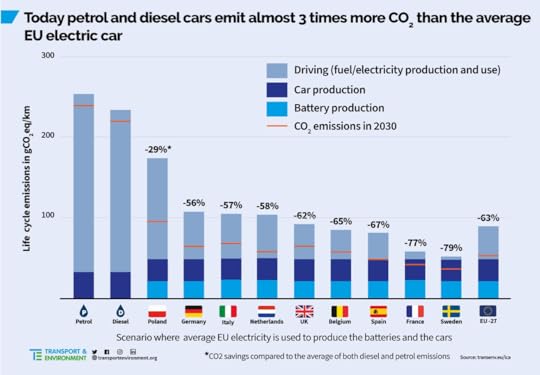 Most car emissions (almost 90%) come from the fossil fuels burned to drive it. Electric cars have a slightly higher carbon cost to produce, but even when they’re powered by dirty energy, they’re a cleaner choice. In the best case (Sweden!), they’re almost 80% less polluting overall. Source: Lucien Mathieu, Transport & Environment, 2020
Most car emissions (almost 90%) come from the fossil fuels burned to drive it. Electric cars have a slightly higher carbon cost to produce, but even when they’re powered by dirty energy, they’re a cleaner choice. In the best case (Sweden!), they’re almost 80% less polluting overall. Source: Lucien Mathieu, Transport & Environment, 2020On average, once you’ve driven an electric car for 23,000 km (about 14,000 miles), you have “repaid your carbon debt”. From then on, you’re polluting less than you would have if you kept your old gasoline car. In the best case, where the battery is produced and charged on clean electricity, you’re already on the carbon-positive side in about half that time.
You can use this calculator from Transport & Environment to compare climate pollution from your current car with an electric one.
The cleaner the energy grid where you’re charging the electric car, the lower overall emissions will be. But no matter where you are in the world, electric vehicles are better than fossil-powered ones. (Here’s how Europe, the US, China, and India stack up.)
Actions: When to Buy vs. Hold for ClimateFor stuff that doesn’t require fossil fuels to use, like clothes, furniture, and tools, follow the Buyerarchy of Needs: first use what you have, then borrow, swap, thrift, or make. Only buy new what you genuinely need after you’ve pursued those other options.
When it’s time to replace something that runs on fossil fuels, buy a version that does not run on fossil fuels. For heaven’s sake, in the Year of Our Carbon Budget 2022 and beyond, please do not buy any new cars, stoves, heaters, … that run on fossil fuels like gas, petrol, propane, etc.
If you have a car, switch to a fossil-free car as soon as you can. It’s a win for the climate to scrap your old car even before it needs replacing.
DeCARbonize your car first, before your home: If you drive, you will save way more emissions replacing a fossil car with a non-fossil car than with any energy upgrades you can make at home.
Once you’ve deCARbonized (ha!), in terms of home energy upgrades, after switching to renewable energy, the biggest carbon savings come from replacing your fossil-powered home heater with a heat pump.
If you’re fossil-car-free and your heat pump is humming merrily along, and you want to do more replace your gas water heater and then your gas stove with electric ones.
Support organisations and tell your politician you support policies to set a stop date for selling things that run on fossil fuels, including a phase-out (BAN!) on cars with internal combustion engines.
Coltura is working for a gasoline-free America.
In the EU, several countries have set timelines for banning ICE vehicles as soon as 2030, and the Fit for 55 package that aims to allow only zero-emission vehicles from 2035 is now in progress.
NGOs including Transport & Environment in the EU and Possible in the UK are campaigning for sustainable transport, including getting rid of fossil cars.
Shout-out to We Can Fix It readers Anna S., Jennifer, and Anna B. for inspiring this month’s actions!
Upcoming EventsRemember my advice from April 2021 (based on this study):
if you have money to spend on climate action, don’t buy offsets. Donate it to politicians running on a strong climate platform, especially supporting scrappy challengers against incumbents with a bad climate voting record early in the election cycle in close races.
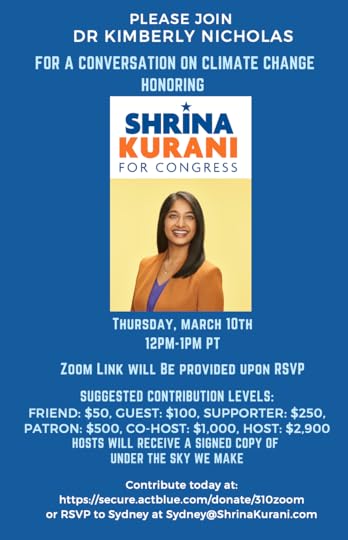
Well here is your chance to do exactly that! Climate champion and my brilliant former student, Shrina Kurani, is running for US Congress, against a long-time incumbent with a terrible 7% lifetime environmental score, in a district that’s newly competitive. Please donate what you can to support Shrina’s campaign, and join our event on March 10. (Note you must be a US citizen or green card holder to contribute to American elections.) Thank you!
Kim on the InterwebsI spoke w/ Steve Lamb about being a good ancestor on Impact Adventures. Listen:
Recently Enjoyed:Reading Parenting in a Changing Climate, by Elizabeth Bechard, felt like a heart-to-heart with a wise friend. This beautifully written book is welcoming and galvanising. Check out my Goodreads highlights and get your own copy!
Turmeric-Black Pepper Tofu with Asparagus, by Ali Slagle, was super quick & tasty.
Take care friends!
xo, Kim
P.S. I heard from Linda that the color scheme I’d been using for these posts was hard to read. I’m sorry! What do you think of this new one?? LMK!
January 28, 2022
System change is a circle, not a waterfall
It’s our one-year anniversary of facing the climate crisis with facts, feelings, and action at We Can Fix It! Thanks for being here— we need you now more than ever.
If you’re new, welcome! Subscribe to join Team Climate & get your monthly update:
Facts: System change is a circle, not a waterfallWhen was the last time you heard one of these claims?
“It’s the top 100 oil companies responsible for over 70% of industrial climate pollution who have to fix climate change.”
“Climate change is a systemic problem; the only way to fix it is to fix the system.”
I want to unpack these ideas a bit.
As you know, dear reader, I am furious about the fossil fuel industry’s history of climate disinformation and delay; and critical of their greenwashing and attempts to avoid real, radical emissions reductions. I strongly support political and collective action (like here and here) to get governments to live up to their promises to stop catastrophic climate change, and am personally engaged in climate activism.
AND! To stop climate change, we have to make a fast, fair transition to a zero-carbon society and world. This will take social change at several levels, including:
political, to put policies and incentives in place so that everyone can meet their needs without causing climate change;
practical, to shut down polluting infrastructure and tech and replace it with climate-friendly ones; and
personal, which includes not only our individual behaviours, but also our cultural and social values and practices.
These “three spheres of transformation” are connected and help motivate and reinforce each other. Importantly, many of the key leverage points for a sustainability transformation are at the level of values (like justice, inclusion, reduced inequalities, and redefining the good life), and norms (social expectations) and practices (like reducing total consumption and waste). Transformation needs to include this deepest level of change, including beliefs, paradigms and mindsets. It doesn’t work to “only” change policy, because policy doesn’t get created in a vacuum.
What’s “the system” we’re trying to change?I see the major actors in society as government, business, and people (sometimes called civil society or non-governmental organisations, NGOs). These actors are part of a system where they’re all connected to each other in a circle through relationships, which I’ve illustrated below. One cycle (shown in yellow) focuses on the power concentrated with business, which shapes government policy through lobbying. Governments shape people’s beliefs and behavior through education and incentives (like subsidies and taxes). People generate demand for products and services, which businesses meet.
Relationships also flow in the other direction (green arrows), where people are foundational in shaping government through their citizenship activities (e.g., voting, lobbying, social movements). Influenced by their citizens, governments set the boundaries (regulatory, legal, political) within which business must operate, and thereby steer what can be produced and supplied for people’s consumption.
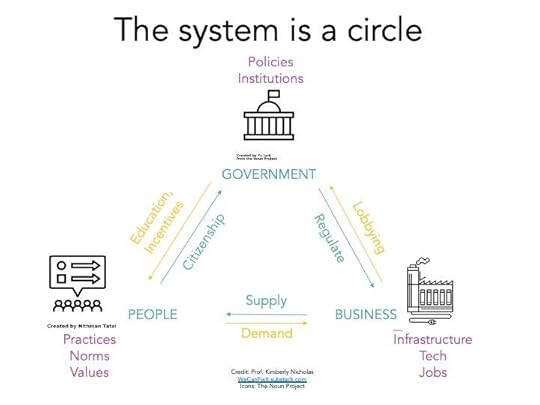 a.image2.image-link.image2-540-720 { display: inline; padding-bottom: 75%; padding-bottom: min(75%, 540px); width: 100%; height: 0; } a.image2.image-link.image2-540-720 img { max-width: 720px; max-height: 540px; } The major actors (shown in blue) are governments, business, and people (both individuals and civil society). Relationships and influence flow in both directions between each actor, shown with arrows. Actors produce the outputs in purple. Icons from The Noun Project. Image: Kimberly NicholasWhy is the system broken?
a.image2.image-link.image2-540-720 { display: inline; padding-bottom: 75%; padding-bottom: min(75%, 540px); width: 100%; height: 0; } a.image2.image-link.image2-540-720 img { max-width: 720px; max-height: 540px; } The major actors (shown in blue) are governments, business, and people (both individuals and civil society). Relationships and influence flow in both directions between each actor, shown with arrows. Actors produce the outputs in purple. Icons from The Noun Project. Image: Kimberly NicholasWhy is the system broken? Right now we have a system locked in to pollution, which you can trace in the yellow cycle above:
… today’s high‐carbon system is not purely chance; actors with social, economic, and political power actively work to reinforce the status quo that favors them. Further, interactions between today’s high‐carbon infrastructure, policies, and lifestyles and culture tend to entrench further carbon lock‐in.
—me in UNDER THE SKY WE MAKE
The good folks at Climate Outreach picture the current system as a vicious cycle: people don’t prioritize climate action, so governments keep dragging their feet on climate policy, allowing companies to continue polluting business as usual, and upholding high-carbon behaviors, norms, and values.
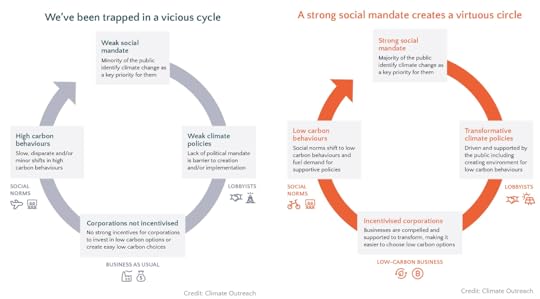 a.image2.image-link.image2-807-728 { display: inline; padding-bottom: 110.85164835164835%; padding-bottom: min(110.85164835164835%, 807px); width: 100%; height: 0; } a.image2.image-link.image2-807-728 img { max-width: 728px; max-height: 807px; } From status quo to the world we’re trying to create! Images: Climate OutreachHow do we fix the system?
a.image2.image-link.image2-807-728 { display: inline; padding-bottom: 110.85164835164835%; padding-bottom: min(110.85164835164835%, 807px); width: 100%; height: 0; } a.image2.image-link.image2-807-728 img { max-width: 728px; max-height: 807px; } From status quo to the world we’re trying to create! Images: Climate OutreachHow do we fix the system? Fortunately, the politics of how to break this vicious circle are becoming clear. Steven Bernstein and Matthew Hoffmann argue it will take three political processes. First, cultural change, where new mindsets and practices shift expectations and norms; second, building capacity to decarbonize, through everything from education to institutional reforms; and third, using incentives and social movements to build coalitions that bring together and empower the many but diffuse interests who would benefit from decarbonization.
-me in UNDER THE SKY WE MAKE
Climate Outreach shows how citizens prioritising climate action leads to transformative climate policies, which hit businesses with both carrots and sticks to transform to zero carbon products and services, which are appreciated and adopted by consumers living low-carbon lifestyles, and fuel further support for climate action. Change at any point in this virtuous circle helps unlock change in other parts of the system, and moves the whole system towards transformation.
System change is not a waterfallI want to contrast my circular view of the system we’re trying to change, outlined above, with the view that the system is determined by its structure. This linear view is more like a waterfall. It implies that top-down laws and regulations from governments are the only way to make meaningful change happen, via changing what businesses produce, which people passively consume.
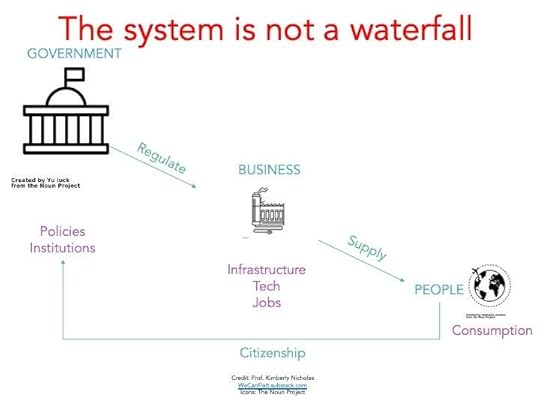 a.image2.image-link.image2-423-564 { display: inline; padding-bottom: 75%; padding-bottom: min(75%, 423px); width: 100%; height: 0; } a.image2.image-link.image2-423-564 img { max-width: 564px; max-height: 423px; } In a linear view, system change comes only from the top down. This view ignores the dynamics of the system, and the power of relationships between actors. Image: Kimberly Nicholas
a.image2.image-link.image2-423-564 { display: inline; padding-bottom: 75%; padding-bottom: min(75%, 423px); width: 100%; height: 0; } a.image2.image-link.image2-423-564 img { max-width: 564px; max-height: 423px; } In a linear view, system change comes only from the top down. This view ignores the dynamics of the system, and the power of relationships between actors. Image: Kimberly Nicholas The problem I have with the waterfall model is that it ignores the dynamics of the system, the power of relationships between actors, and diminishes people’s agency. It reduces the scope of “valid” climate action to only the political sphere.
We desperately need more, stronger, louder climate citizens! AND: we also need people to engage in high-impact climate actions throughout the lives they lead right now. Only a small fraction of the most concerned are politically engaged. Most people don’t think of political action when they think of climate action.
That’s why I consistently focus on high-impact climate actions across the key domains where your actions do make a difference, both for yourself and in pushing for wider system change: as a consumer, investor, at work, as a role model, and as a citizen. Please keep working in the ways you care about most, and support people working for positive change on any and every level. <3
Feelings: LonelyI hear from a lot of readers who feel climate-lonely, like Bill, who wrote me from Florida. He doesn’t hear his local politicians, media, or friends talking about climate. Bill feels like he’s the only one thinking or worrying about climate, or taking action.
Feeling alone is tough; it can be demotivating, and sap your energy.
Good news: you’re really not alone!
Let’s look at Bill’s case, in Florida— a state that voted in 2020 for the previous president who was, ahem, not a climate champion.
In Jacksonville, Florida, 72% of Bill’s neighbours think (correctly!) that global warming is happening, 64% are worried about it, and 86% support funding renewable energy research.
If you’re in the US, have a look at the Yale maps— maybe you’re not as alone as it feels!
 a.image2.image-link.image2-414-568 { display: inline; padding-bottom: 72.8021978021978%; padding-bottom: min(72.8021978021978%, 413.5164835164835px); width: 100%; height: 0; } a.image2.image-link.image2-414-568 img { max-width: 568px; max-height: 413.5164835164835px; } Source: Yale Climate Opinion Maps
a.image2.image-link.image2-414-568 { display: inline; padding-bottom: 72.8021978021978%; padding-bottom: min(72.8021978021978%, 413.5164835164835px); width: 100%; height: 0; } a.image2.image-link.image2-414-568 img { max-width: 568px; max-height: 413.5164835164835px; } Source: Yale Climate Opinion Maps If you’re feeling climate-lonely, remember these tips on finding your climate peeps!
Action: Level Up Your Climate Media DietMedia plays a critical role in shaping and informing public opinion and values —a key lever for system change!
Members of Parliament rated creating media attention as highly effective.
Media coverage directly increases public concern for climate change.
But climate media coverage is way too low:
Only half of Americans hear about global warming in the media once a month or more.
Major US media outlets were twice as likely to cover press releases opposing climate action as those favoring it, found Rachel Wetts of Brown University.
Your action this month: Follow and support excellent climate media and journalists.Climate news
Climate justice and solutions: Grist
Clear explainers and data visualization: Carbon Brief
Scientists fact-checking climate news: Climate Feedback
Brilliant, haunting long-form features: Elizabeth Kolbert in The New Yorker
Newsletters
My biggest inspiration: The Crucial Years, by the visionary Bill McKibben
Holding polluters accountable: Heated, by Emily Atkin
Intersectional & fearless: HOT TAKE, by Mary Heglar & Amy Westervelt
Wonky policy deep dives: Volts, by David Roberts
Climate finance, CSR, and investing: The Zeroist, by Denise Young
P.S. Follow my Twitter lists of Climate inspiration and Green journalists.
Parting Thoughts Recent events & articlesI want to say a HUGE thank you to the wonderful Beth Novak Milliken and Lindy Novak of Spottswoode Estate Vineyard & Winery, who generously shared copies of UNDER THE SKY WE MAKE with their top customers, & hosted a conversation on wine and climate action with me & Michael Silacci, Viticulturalist & Winemaker for Opus One. You can watch our conversation here.
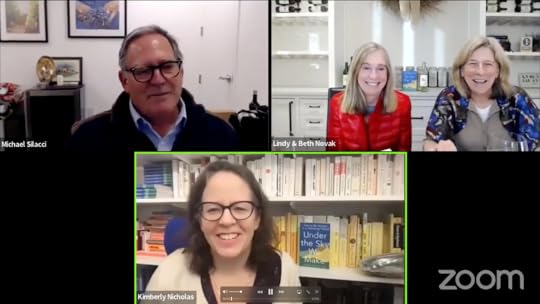 a.image2.image-link.image2-289-512 { display: inline; padding-bottom: 56.31868131868132%; padding-bottom: min(56.31868131868132%, 288.35164835164835px); width: 100%; height: 0; } a.image2.image-link.image2-289-512 img { max-width: 512px; max-height: 288.35164835164835px; } Talking wine and climate action with some of Napa’s best wine producers.Read
a.image2.image-link.image2-289-512 { display: inline; padding-bottom: 56.31868131868132%; padding-bottom: min(56.31868131868132%, 288.35164835164835px); width: 100%; height: 0; } a.image2.image-link.image2-289-512 img { max-width: 512px; max-height: 288.35164835164835px; } Talking wine and climate action with some of Napa’s best wine producers.Read Hey, I read 100 books in 2021! It was such a pleasure to immerse myself in reading again. My tips to read more: (1) no phone in bed; (2) set limit of 30 min/day for social media; (3) track what you want to read on Goodreads and make good use of your library (don't forget e-books and audiobooks). Lmk what you’re reading!
P.S. I hope you and your loved ones have managed as well as possible during this tough phase of the pandemic. For extremely helpful, actionable, and timely pandemic advice, subscribe to Your Local Epidemiologist. To prepare to take care of yourself and others, read my advice in “What I Wish I Knew Before I Got Covid.” Take care friends!
December 10, 2021
Debunking climate guilt in time for the holidays!
Hi friends, welcome to your last newsletter of 2021! Thank you for being on this journey together.
I launched We Can Fix It in January 2021 to provide free, actionable, evidence-based climate guidance, straight from your favorite climate scientist.
This newsletter is a labor of (unpaid!) love for me.
If you want to show some love back, I would be honored if you were moved to help Team Climate grow and spread climate facts, feelings, and action:
Buy my book UNDER THE SKY WE MAKE (makes great holiday gifts!) (Int’l orders)
Write a review of UNDER THE SKY WE MAKE online (this makes a HUGE impact!)
I’m thrilled with how this community has grown. Thank you so much for being here, and for your support.
Here’s what’s shaking this month:
Facts: Staying Grounded Is Taking OffOur new study finds: Staying on the ground is taking off!
Swedish media represented flying for holidays as luxurious starting in the 1950s, and as normalized and desirable for the hypermobile middle class since the 1990s.
But media coverage since 2016 has shifted towards challenging the idea of flying because of its sky-high climate pollution, and advocating taking responsibility for the climate cost of flying.
We show this in a new study from my lab, led by Sara Ullström, who is conducting her PhD within our research project “The Takeoff of Staying on the Ground.”
More deets:
We studied holiday air travel because it’s the most common reason for flying globally. In Sweden, 80% of national flight emissions are caused by leisure and holiday travel.
We analyzed media articles, advertisements, and images from popular Swedish magazines and newspapers, 1950-2019.
We identified three phases, illustrated in the photos below:
Aspirational Luxury, 1950s-1990s
Flying was depicted as an important and appreciated part of the holiday experience; the plane trip was seen as comfortable and luxurious (lol).
Hypermobility, 1990s- present
Holiday flying tended to be represented as a normal part of middle-class Swedish life, and as an escape from everyday pressures.
Staying on the ground, 2016-present
Starting in 2016, a flight-free movement in Sweden is actively contesting the idea of aviation as desirable. This led to media increasingly representing the importance of acting with urgency to tackle the climate crisis; living according to one’s values; taking moral responsibility for climate harm; and enjoying climate-friendly traveling, including finding adventure closer to home.
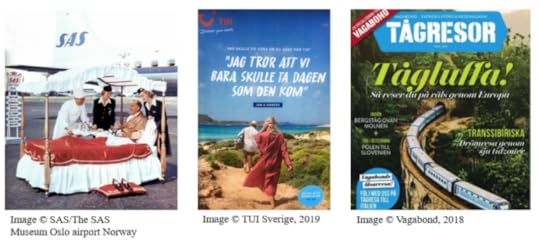 a.image2.image-link.image2-383-728 { display: inline; padding-bottom: 52.60989010989011%; padding-bottom: min(52.60989010989011%, 383px); width: 100%; height: 0; } a.image2.image-link.image2-383-728 img { max-width: 728px; max-height: 383px; } We identified three phases of views on holiday flying in Swedish media: Aspirational luxury (left), where flying was viewed as glamorous; Hypermobility (center), where middle-class travelers fly to create time away from the daily grind; and Staying on the Ground (right), where travel is conceived as exploration, experiences, and appreciation of the journey. Source: Ullström, Stripple, and Nicholas, 2021
a.image2.image-link.image2-383-728 { display: inline; padding-bottom: 52.60989010989011%; padding-bottom: min(52.60989010989011%, 383px); width: 100%; height: 0; } a.image2.image-link.image2-383-728 img { max-width: 728px; max-height: 383px; } We identified three phases of views on holiday flying in Swedish media: Aspirational luxury (left), where flying was viewed as glamorous; Hypermobility (center), where middle-class travelers fly to create time away from the daily grind; and Staying on the Ground (right), where travel is conceived as exploration, experiences, and appreciation of the journey. Source: Ullström, Stripple, and Nicholas, 2021 We traced how five themes evolved over time across these three phases. For example, in looking at the theme of the purpose of vacation, we found that the idea of a holiday as restorative has been consistent over time. But the way to achieve that purpose is shifting from flying to find sunshine, towards searching out experiences closer to home (like the local wine tasting and moose safaris in “Experience exotic Sweden”).
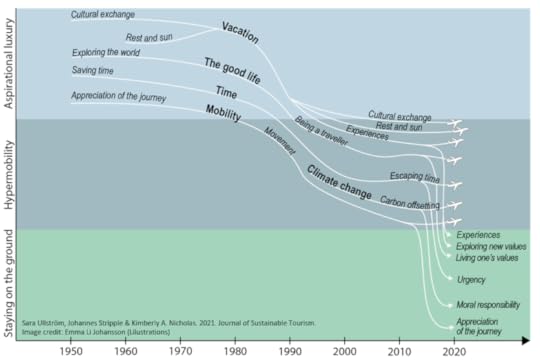 a.image2.image-link.image2-560-728 { display: inline; padding-bottom: 76.92307692307693%; padding-bottom: min(76.92307692307693%, 560px); width: 100%; height: 0; } a.image2.image-link.image2-560-728 img { max-width: 728px; max-height: 560px; } From our media analysis, we identified three phases of views on holiday air travel, and traced five themes across them: the purpose of vacation, ideas of the good life, time, mobility, and climate change.
a.image2.image-link.image2-560-728 { display: inline; padding-bottom: 76.92307692307693%; padding-bottom: min(76.92307692307693%, 560px); width: 100%; height: 0; } a.image2.image-link.image2-560-728 img { max-width: 728px; max-height: 560px; } From our media analysis, we identified three phases of views on holiday air travel, and traced five themes across them: the purpose of vacation, ideas of the good life, time, mobility, and climate change. The shift in themes over time indicates the start of an important shift in culture, where what constitutes "the good life" is not defined by "what you consume" (travel experiences), or an identity derived from your travel consumption, but instead towards living one's values.
Read more: Our article in The Conversation: “Sweden’s flight-free movement,” and the full study.
Feelings: GuiltI think there’s way too much focus on climate guilt, and it’s mostly unhelpful.
But this is NOT another rant exhorting you:
“Give up your guilt” about your climate “sins”!
Don’t fall for climate “purity tests”!
Climate change is not your fault, it’s all the fault of oil companies and governments!
Instead, I’m telling you to examine your climate guilt, because it’s either (a) unnecessary or (b) useful but misunderstood.
Guilt vs. shameLet’s start with some definitions:
Guilt: feeling bad for doing something bad. Guilt can be “adaptive and helpful” because it holds our actions up to our values.
Guilting: trying to manipulate someone else’s behavior by making them feel bad about their actions. Familiar to Catholic school alums like me everywhere.
Shame: feeling bad because you believe you are bad, “unworthy of love and belonging,” as Brené Brown puts it. Shame is part of your identity. Sad face.
Shaming: causing someone to feel inadequate or worthless as a human being, especially in comparison to a social expectation. Not cool, man.
From guilt to moral responsibilityOf course, as a We Can Fix It reader, you already know that fossil fuel companies are spreading misinformation and greenwashing, while governments are failing to keep their Paris Agreement promises. Governments and companies absolutely need to be held to account! (See We Can Fix It Actions from February, March, May, July, and September 2021 for some ideas on how.)
But you also know that, to prevent catastrophic climate change, the rich need to get to work. If your carbon footprint is way above average for your country, then system change won’t be enough to stabilize the climate— you also have to curb your overconsumption.
I’d love to develop a more helpful and honest view of climate responsibility that holds governments and oil companies to account, and also gets people engaged from where they are in high-impact climate action.
An unintended consequence of calling exclusively for overhauling huge, abstract systems is that most people don’t see a path for how they can contribute from where they are right now— so they shut down and don’t do anything.
We need to think more deeply about climate responsibility, in ways that get those with the most power and historical emissions to rapidly reduce them, which is a key element of climate justice.
Climate responsibility applies to countries, companies, and individuals, as I wrote for Carbon Brief:
“Flight shaming” is not a thingWe who have driven the most warming must drive the transformation to stop it. At the national level, this puts special responsibility on the US and Europe, where about 12% of the global population have spewed half the world’s fossil pollution. At the company level, it’s the 100 companies behind 71% of industrial greenhouse gas emissions. At the individual level, the super-rich “polluter elite” are clear offenders, but we can’t ignore those of us in the global richest 10%, earning $38,000 and up, who account for about half of household carbon pollution.
International media often mis-labels the flight-free movement that I study in Sweden as the “flight shame movement” or even the “flight shaming movement”. This creates the false perception that the movement is actively trying to point the finger at others.
But research by Nina Wormbs and Maria Wolrath Söderberg shows the opposite. Their study of nearly 700 people who had actually stopped flying (not just opined about it on social media) found that they did so because of a combination of knowledge and following their conscience, supported by role models and supportive communities. Shame did not motivate their actions; rather, they reported a sense of agency and responsibility.
This sense of agency and responsibility aligns with what we found in our new study, where people are questioning the previously accepted norm that frequent flying is necessary, good, or high status. I think changes in high-impact climate behaviors like staying on the ground are better understood as part of a cultural shift through role modeling, as Seth Wynes recently told Sammy Roth in the LA Times:
Action: A Holiday With Climate Love“If you picture a world where our culture shifts quickly and we actually tackle climate change, and manage to amazingly do this rapid decarbonization and achieve 1.5 degrees — in that vision of the world, do you see celebrities and major league sports and other elites and role models just continuing in their status quo [of frequent flying]?” he asked. “That’s really unlikely. And so I would see it as being a meaningful part of a cultural shift that would need to take place.”
Here’s a depressing fact: we spend six times more on Christmas shopping than the entire annual budget for climate and environment. And that’s in my beloved green paradise (ahem), Sweden!
Meanwhile, only 13% of Americans have donated money to a climate organization, and only 6% volunteer their time for one, according to Yale surveys.
In this season of reflecting, gratitude, and giving, how about creating new holiday traditions in line with what really matters? Here are some ideas:
Reflect on what mattersTake some time to reflect (journal, discuss with loved ones): What do the holidays mean to you? What traditions and memories do you want to honor? Which ones just add stress and stuff?
Simplify the holidaysCheck out the Simplify the Holidays campaign about “giving back with more fun and less stuff!” They have a guide for talking with family about building meaningful, earth-friendly traditions; tips for simpler entertaining like cookie swaps; social media shareables; and ideas for gifts of food, charity donations, and quality time.
 a.image2.image-link.image2-340-340 { display: inline; padding-bottom: 100%; padding-bottom: min(100%, 340px); width: 100%; height: 0; } a.image2.image-link.image2-340-340 img { max-width: 340px; max-height: 340px; } Source: Simplify the Holidays, Center for Biological DiversityHoliday cards
a.image2.image-link.image2-340-340 { display: inline; padding-bottom: 100%; padding-bottom: min(100%, 340px); width: 100%; height: 0; } a.image2.image-link.image2-340-340 img { max-width: 340px; max-height: 340px; } Source: Simplify the Holidays, Center for Biological DiversityHoliday cards It’s a joy to share photos and updates of family at the holidays. But have you reflected on what values you’re sharing with your photos and letter? Often these letters exalt carbon-intensive activities, with photos of the family flown in to an exotic setting. We know this role modeling helps reinforce a culture of high consumption and carbon lock-in.
What would a climate-friendly holiday card look like?
I was recently inspired by a holiday card from Wendy, who shared how her family hikes through forests dying of drought and wildfire saddened and worried her, and also sparked her to take action. She started a Giving Circle to raise support for an environmental charity, and her letter includes tips and links from friends about the climate actions they’re taking, and asking them to share these in their holiday cards.
Fix stuff as a gift, or togetherAs journalist Whitney Bauck points out, “the most sustainable sneakers are the ones you already own.”
Whitney gave her sister an amazing gift of time, to lovingly clean her favorite sneakers so they’re like new! She also hosted a mending party on a Brooklyn rooftop that looks super fun and doable.
 a.image2.image-link.image2-358-532 { display: inline; padding-bottom: 67.18181818181819%; padding-bottom: min(67.18181818181819%, 357.40727272727275px); width: 100%; height: 0; } a.image2.image-link.image2-358-532 img { max-width: 532px; max-height: 357.40727272727275px; } Check out Whitney Bauck’s quick sneaker makeover video on TikTok. Start a climate book club for 2022
a.image2.image-link.image2-358-532 { display: inline; padding-bottom: 67.18181818181819%; padding-bottom: min(67.18181818181819%, 357.40727272727275px); width: 100%; height: 0; } a.image2.image-link.image2-358-532 img { max-width: 532px; max-height: 357.40727272727275px; } Check out Whitney Bauck’s quick sneaker makeover video on TikTok. Start a climate book club for 2022 I LOVE my two book clubs (one climate, one not). It’s a wonderful way to spend time with friends, talk through big things, and help figure out how you can help.
Of course I agree with holiday gift guides from mindbodygreen and Bloomberg Green, who recommend giving and discussing MY book, Under the Sky We Make. (Check out the handy discussion guide, and I can Zoom in to your book club!)
Climate books I loved in 2021 for reading inspo (check out the archive for reviews):
All We Can Save, Ayana Elizabeth Johnson & Katharine Wilkinson (Jan 2021)
Youth to Power: Your Voice and How To Use It, by Jamie Margolin (Feb 2021)
The Loneliest Polar Bear, by Kale Williams (March 2021)
Ministry for the Future, by Kim Stanley Robinson (Apr 2021)
Under a White Sky, by Elizabeth Kolbert (May 2021)
Too Hot to Handle? The Democratic Challenge of Climate Change, by Rebecca Willis (Summer 2021)
A Children’s Bible, by Lydia Millet (Sept 2021)
Hot Mess, by Matt Winning (October 2021)
Parting Thoughts and TidbitsI spoke with Ryan Katz-Rosene on the EcoPolitics Podcast about what it means to be an eco-citizen, and wrote for Decanter why wine lovers need to become climate activists.
Have a restorative holiday, and see you in January!
November 9, 2021
Live Discussion: What do you need more of?
What do you need to do your best climate work, and how can we create more of it?
Welcome to our first-ever discussion thread for We Can Fix It subscribers! I’ll be live on Substack in text conversation with the We Can Fix It community starting now, for the next 2 hours— join in by clicking the button below!
All the best,
Kim
October 28, 2021
Your Top 5 Climate Superpowers
Hi friends, welcome to decorative gourd season, and to We Can Fix It: your friendly expert guide to making high-impact climate action happen throughout your life, armed with a healthy dose of facts and feels.
If you’re new, click this button to join the team. And away we go!
Facts: Your Top 5 Climate SuperpowersThis month, the hot-off-the-press climate facts come from yours truly! With lovely colleagues in a team led by Kristian Nielsen, our new study in Nature Energy shows how the global movers and shakers can either:
(a) continue to lock in climate catastrophe, or
(b) lead the transformation to a stable climate. (Let’s choose this option!)
In the study, my colleagues and I look at the super-rich “polluter elite”. But we’re also looking at ourselves, because our college education, white-collar jobs, prosperous neighborhoods, and income over $38,000 a year means we (and maybe you?) are of “high socio-economic status” globally.
This status gives us disproportionate power and responsibility that will be critical for averting catastrophic climate change.
The takeaway: there are five key roles where your actions can have outsized impact: as consumers, investors, role models, as part of organizations, and as citizens.
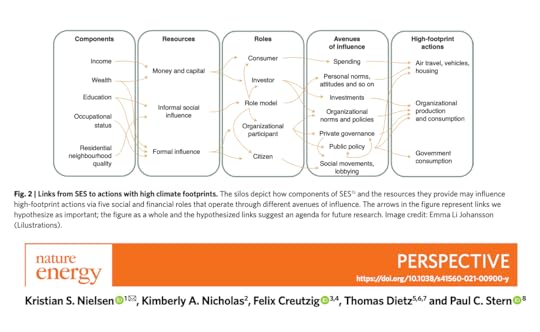 a.image2.image-link.image2-896-1456 { padding-bottom: 61.53846153846154%; padding-bottom: min(61.53846153846154%, 896px); width: 100%; height: 0; } a.image2.image-link.image2-896-1456 img { max-width: 1456px; max-height: 896px; } How people of high socio-economic status can mobilize their power for high-impact climate action. Thank you Emma Johansson for illustrating!
a.image2.image-link.image2-896-1456 { padding-bottom: 61.53846153846154%; padding-bottom: min(61.53846153846154%, 896px); width: 100%; height: 0; } a.image2.image-link.image2-896-1456 img { max-width: 1456px; max-height: 896px; } How people of high socio-economic status can mobilize their power for high-impact climate action. Thank you Emma Johansson for illustrating!Kristian and I summarized the 5 roles in a comment for New Scientist. Key highlights:
Consumer
“The group earning over $38,000 a year makes up the top 10 per cent of income globally, and is responsible for half of the carbon pollution emitted by households. As you ascend the income scale to $109,000, you reach the global 1 per cent, whose individual climate pollution is 30 times above the sustainable limit for 2030.
The majority of this climate pollution is created through frequent and long-distance travel by plane and car, followed by home energy use.” (Reminder from We Can Fix It July 2021: here’s how to align your consumption with climate.)
Investor
“If you have a pension, or savings in investment accounts at a major bank, chances are you are currently financing climate destruction via loans and investments to expand and support fossil fuel pipelines and power plants. To support climate stability instead, shift your money from banks and pension funds and stocks that still finance fossil fuel companies. Support campaigns to get universities, schools and businesses to divest from fossil fuels.”
Role model
“Social influence increases with status, but we all influence those around us through our words and, especially, our actions. We can use this influence with family, friends, neighbours and colleagues to promote climate-friendly aspirations and norms in our networks and communities. One simple way to wield this influence is through shifting social media posts away from celebrating conspicuous consumption of tropical holidays and fat steaks, and towards simpler pleasures of time with family and friends and in nature closer to home.”
At work or school
“You can also press for climate action in the organisations where you work, play or study. Speak up for and drive policies for decarbonising industries and supply chains, and advocating for philanthropy. The recent Project Drawdown guide Climate Solutions at Work offers practical advice on how to make every job a climate job, while the Science Based Targets initiative sets pathways for companies to do their fair share to meet the goals of the Paris Agreement.”
Citizen
“As citizens, voting is a powerful climate action. Those of us lucky enough to live in the 18 per cent of countries that meet high democratic standards should use this power. Until now, political access and influence have mainly been used to promote fossil fuel and other corporate interests in policy-making. This can change by making climate a leading political and election issue through social mobilisation and lobbying, and by holding representatives accountable for their climate votes and directly contacting them, especially as many representatives report feeling very little pressure from their constituents to take climate action.”
Want more? Read the study in Nature Energy, the full comment piece by me and Kristian quoted above, or some of the press coverage of the work:
BBC // Forbes // Grist // Dagens Nyheter (Swedish) // Der Spiegel (German)).
Feelings: Don’t worry about worryLast week I attended a great session about climate feelings at the excellent Beyond Oil conference. (I joined digitally; it was a very well-run hybrid conference blending in-person and virtual participation.)
First was Ida Vikøren Andersen, sharing her research on how young people express climate fear. She found that the most common reason for fear was political inaction (a very legit reason!).
Overall, she finds that climate fear is not paralyzing (as earlier believed).
Instead, fear can orient towards action *if* people have agency (they know what to do, and can start to do it).
Check out the powerful quotations from her talk:
#BeyondOil2021 ","username":"KA_Nicholas","name":"Prof. Kimberly Nicholas","date":"Wed Oct 20 13:04:11 +0000 2021","photos":[{"img_url":"https://pbs.substack.com/media/FCJPjq... Prof. Kimberly Nicholas @KA_NicholasHow do young people express fear about the climate crisis? Ida Vikøren Andersen finds the most common reason is lack of political action. Fear can be both personally directed (feeling unseen/unheard) and socially (collective action). #BeyondOil2021
Prof. Kimberly Nicholas @KA_NicholasHow do young people express fear about the climate crisis? Ida Vikøren Andersen finds the most common reason is lack of political action. Fear can be both personally directed (feeling unseen/unheard) and socially (collective action). #BeyondOil2021 
October 20th 2021
13 Retweets36 LikesIn the same session, Thea Gregersen, who studies climate psychology, said:
"I'm more afraid of false hope than fear."
(The reason false hope is scary: a study led by Jennifer Marlon found that the false hope that someone or something else will fix the climate prevents people from taking meaningful action.)
Thea Gregersen advised:
You don't need to hope climate change will solve itself, but that you can make a difference.
Most climate change worry is productive; there’s very little in psychology literature to indicate fear or worry is negative.
Don't worry about climate worry itself. You can treat climate worry by showing that you're actually doing something, and make it easy for others to actually do something.
Meanwhile, a new Yale survey shows that US climate worry is at all-time high. Let’s keep reaching out to invite the worried to join Team Climate! (Feel free to forward this newsletter to them.)
Managing emotions to stay in the “window of tolerance” where we can be our best selves is a key life skill in the climate crisis (and just in general). Dr. Britt Wray has some great tips on how to cope:
@NPRLifeKit pod about coping with climate distress. Tips on how to:\n\nFind a way to reset and calm your central nervous system\n\nFind someone to talk to, not just a therapist (though that's great too)\n\nChannel your feelings to connect w/ others \n\n","username":"brittwray","name":"Dr. Britt Wray","date":"Mon Oct 25 20:51:22 +0000 2021","photos":[],"quoted_tweet":{},"retweet_count":25,"like_count":73,"expanded_url":{"url":"https://www.npr.org/2021/10/23/104775... from climate change isn’t going away. Here’s how you can manage it","description":"Feeling anxious about the climate crisis is a totally normal response, says ecotherapist Phoenix Smith. Here’s how you can manage those feelings for the decades to come.","domain":"npr.org"},"video_url":null}"> Dr. Britt Wray @brittwrayI spoke w/ @NPRLifeKit pod about coping with climate distress. Tips on how to:Find a way to reset and calm your central nervous systemFind someone to talk to, not just a therapist (though that's great too)Channel your feelings to connect w/ others
Dr. Britt Wray @brittwrayI spoke w/ @NPRLifeKit pod about coping with climate distress. Tips on how to:Find a way to reset and calm your central nervous systemFind someone to talk to, not just a therapist (though that's great too)Channel your feelings to connect w/ others  Anxiety from climate change isn’t going away. Here’s how you can manage itFeeling anxious about the climate crisis is a totally normal response, says ecotherapist Phoenix Smith. Here’s how you can manage those feelings for the decades to come.npr.org
Anxiety from climate change isn’t going away. Here’s how you can manage itFeeling anxious about the climate crisis is a totally normal response, says ecotherapist Phoenix Smith. Here’s how you can manage those feelings for the decades to come.npr.orgOctober 25th 2021
25 Retweets73 LikesAction: Join The 1st We Can Fix It Thread!Last month at We Can Fix It, we talked about building climate community. It’s so important to know we’re in this work together!
I heard from a lot of readers that you’re keen to join a discussion with your fellow We Can Fix It peeps. I’m excited to connect you all, and frankly, to show off how awesome you are.
So this month’s action will be to:
Mark your calendar and join us for our first-ever We Can Fix It Discussion Thread!
Tuesday, November 9, from 19:00-21:00 in Sweden (see other time zones below). You can drop in anytime in that window, even just for a few minutes.
What’s a Discussion Thread?
Threads are where I’ll kickstart a conversation with an open question. You’ll get a copy of the question in your inbox, and a link to join the thread when it’s live, so keep an eye on your email at the appointed hour and click to join.
Subscribers (that’s you!) can click the link you’ll get on November 9th to answer live, and take the conversation further with each other and with me. Here’s an example thread so you can see what it looks like (but ours will be about climate, not Game of Thrones!).
 a.image2.image-link.image2-524-1456 { padding-bottom: 35.989010989010985%; padding-bottom: min(35.989010989010985%, 524px); width: 100%; height: 0; } a.image2.image-link.image2-524-1456 img { max-width: 1456px; max-height: 524px; } Mark your calendars to join the first We Can Fix It Discussion Thread! November 9 from 19:00-21:00 in Sweden (sorry Australia, we’ll get you next time!)
a.image2.image-link.image2-524-1456 { padding-bottom: 35.989010989010985%; padding-bottom: min(35.989010989010985%, 524px); width: 100%; height: 0; } a.image2.image-link.image2-524-1456 img { max-width: 1456px; max-height: 524px; } Mark your calendars to join the first We Can Fix It Discussion Thread! November 9 from 19:00-21:00 in Sweden (sorry Australia, we’ll get you next time!)Every day is a good day to talk climate, but especially the day of our Discussion Thread, which will be in the second week of the United Nations climate conference COP26, where world leaders are also talking climate. I’ve previously attended two of these conferences as an Observer (Paris in 2015 and Bonn in 2017), and will be keeping track of this one digitally, so that’s one possible topic I’m pondering!
(Btw, if you want to get up to speed on what’s at stake and where countries stand for the COP, see this great overview by my favorite international climate policy expert and We Can Fix It reader Taryn Fransen).
Parting Thoughts and TidbitsRecently Enjoyed:Read: I got to read an advance copy of Hot Mess, by standup comedian and climate economist Matt Winning, and I highly recommend! As I write in my blurb (endorsement): “It’s the first book about climate change that made me laugh out loud. Hot Mess is the kick in the pants you need to start making yourself useful.” Get it at your local bookstore starting November 11, or pre-order it now to show some climate love! (Pre-orders are one of the best possible ways to support an author.)
Move: Days are getting short in Sweden. On the rare moments when the sun is out, I try to drop everything and go enjoy it. I’ve been hosting work meetings as walks in Lund’s beautiful Botanical Garden. An hour “walkshop” chatting with a colleague is also time in nature, and over 6,000 steps and 5km/3 miles. What work meetings or connections with friends can you take outside?
Make: Simon and I invested in an extendable apple picker, crusher, and press, and suddenly we have apple cider blurpily fermenting in our kitchen! We made our first batch in August with Gen and Erik, using apples from our Transparent Blanche tree, and just made our second batch from a bunch of apples we picked to rescue them from becoming slug food on the ground. Sorry slugs, your loss is our gain!
 a.image2.image-link.image2-291-388 { padding-bottom: 75%; padding-bottom: min(75%, 291px); width: 100%; height: 0; } a.image2.image-link.image2-291-388 img { max-width: 388px; max-height: 291px; } Apples ready for crushing last weekend. Photo: KN
a.image2.image-link.image2-291-388 { padding-bottom: 75%; padding-bottom: min(75%, 291px); width: 100%; height: 0; } a.image2.image-link.image2-291-388 img { max-width: 388px; max-height: 291px; } Apples ready for crushing last weekend. Photo: KN
September 30, 2021
When the pandemic + fire hit my family
Hello friends! I’m glad you’re here at We Can Fix It. The best time to live out climate facts, feelings, and action was 30 years ago, but the second-best time is now!
If someone forwarded you this post, please jump onboard by clicking this button.
Let’s dive in!
Facts: New Facts Agree With Old FactsThe Big Bad Mothership of Climate Facts came out with a new report last month, so picking which Facts to cover for this edition was kind of a gimme. When the Intergovernmental Panel on Climate Change (IPCC) drops one of their massive Fact Tomes, with a summary compiled by all-star scientists and approved line-by-line by the world’s governments, I am here for it.
On IPCC launch day, I girded my climate loins. I shared resources for focus, courage, and action, which we need every day, not just every IPCC day (<0.01% of the days). Here’s my complete advice.
#climatecrisis is tough! Here’s the essentials you need to know, tips for finding where you can contribute with purpose and meaning to the work needed, and evidence-based high-impact climate actions. A THREAD: 1/n ","username":"KA_Nicholas","name":"Prof. Kimberly Nicholas","date":"Mon Aug 09 07:54:53 +0000 2021","photos":[{"img_url":"https://pbs.substack.com/media/E8VWwy... Prof. Kimberly Nicholas @KA_NicholasHi, it’s your friendly neighborhood climate scientist. Facing the #climatecrisis is tough! Here’s the essentials you need to know, tips for finding where you can contribute with purpose and meaning to the work needed, and evidence-based high-impact climate actions. A THREAD: 1/n
Prof. Kimberly Nicholas @KA_NicholasHi, it’s your friendly neighborhood climate scientist. Facing the #climatecrisis is tough! Here’s the essentials you need to know, tips for finding where you can contribute with purpose and meaning to the work needed, and evidence-based high-impact climate actions. A THREAD: 1/n 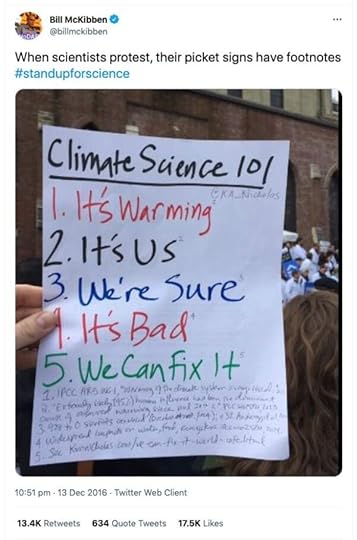
August 9th 2021
1,575 Retweets4,822 LikesAs a We Can Fix It subscriber, you already know the fundamentals of what’s in the IPCC report, because you’ve seen these facts in my Climate Haiku, at the bottom of this email, and baked into Under the Sky We Make — but here’s what’s new:
It’s warming, it’s us, we’re f***ing sure“It is unequivocal that human influence has warmed the atmosphere, ocean and land.” (IPCC AR6 SPM, Statement A.1)
Yep! Science has been saying it’s warming and that humans are causing it (spoiler alert: BY BURNING FOSSIL FUELS, as Emily Atkins made clear) for a long time. What’s new is the level of confidence: “unequivocal” means “leaving no doubt; unambiguous”.
Human-caused warming is a fact. There’s really nowhere to go in the next report after this, except maybe “FFS, like a million percent sure.”
It’s bad: Climate change makes heatwaves & other extremes worse“Human-induced climate change is already affecting many weather and climate extremes in every region across the globe.” (IPCC AR6 SPM, Statement A.3)
Since the last report, hardworking scientists have made big advances in finding the fingerprints of human-caused warming in specific events. For example, they found that the terrible, record-shattering heat in the Pacific Northwest and western Canada this summer would have been “virtually impossible” without human-caused climate change. :(
To look under the hood of attribution science, check out this great Carbon Brief piece, and follow the fast, thorough research of World Weather Attribution.
We can fix it: Yes! But we’re not, yet.“Global warming of 1.5°C and 2°C will be exceed during the 21st century unless deep reductions in CO2 and other greenhouse gas emissions occur in the coming decades.” (IPCC AR6 SPM, Statement B1)
Oh IPCC, why do your rallying cries for fixing it sound like this?? It’s not exactly a catchy slogan, but it does say: It is physically possible to limit global warming to the Paris Agreement targets. Current climate policies are too weak to stop warming; we need much stronger climate policies to slash emissions NOW. Stopping warming requires that humans completely stop adding carbon to the atmosphere. Which we know how to do (refresher on all this: We Can Fix It, May 2021). Let’s get on with it.
Feelings: When the pandemic + fire hit my familyLast summer, my hospitalized father tested positive for COVID-19, and I made an emergency trip home to California. I am forever thankful that my dad made an excellent recovery. But just when he was settling in back at home, the latest round of catastrophic fires started, sending a massive cloud of smoke up from the hills above my parents’ house, and me into a blind panic.
I wrote about when the climate emergency + the pandemic collided for me and my family last summer for Elle Magazine in a piece called, “My Father Was Sick, But It’s My Home That’s Dying.” Please have a read, and let me know what you think.
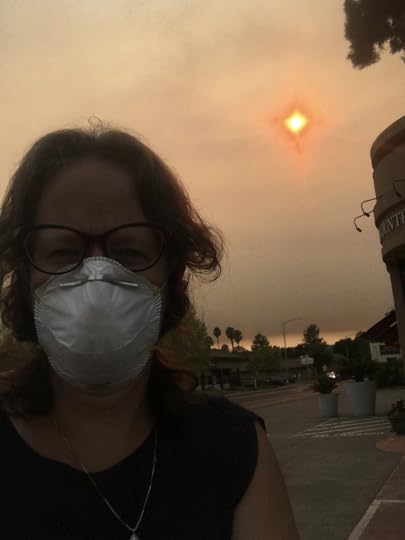 a.image2.image-link.image2-494-370 { padding-bottom: 133.31043956043956%; padding-bottom: min(133.31043956043956%, 493.2486263736264px); width: 100%; height: 0; } a.image2.image-link.image2-494-370 img { max-width: 370px; max-height: 493.2486263736264px; } Me in my hometown of Sonoma, California on August 20, 2020 at 5:30pm, with wildfire smoke turning the sky grey and the sun orange. Action: Find Your Climate Peeps
a.image2.image-link.image2-494-370 { padding-bottom: 133.31043956043956%; padding-bottom: min(133.31043956043956%, 493.2486263736264px); width: 100%; height: 0; } a.image2.image-link.image2-494-370 img { max-width: 370px; max-height: 493.2486263736264px; } Me in my hometown of Sonoma, California on August 20, 2020 at 5:30pm, with wildfire smoke turning the sky grey and the sun orange. Action: Find Your Climate Peeps I hear from a lot of folks who feel alone in the climate crisis. They know and care so much, but they don’t see people around them acting with the necessary urgency. They don’t have friends they can talk to about All the Climate Feels.
If this is you, I want your first climate action to be building community. Do not pass Go. Do not go ballistic over heat pumps. Do not try to rail against this global problem on your own. That is a recipe for frustration, burnout, and despair.
You need to find your Climate Peeps. These are:
(1) people you enjoy hanging out with, and
(2) people you enjoy talking about climate and doing Climate Things with.
You don’t have to ONLY focus on climate with your Climate Peeps; you can talk about everything else too! Climate just has to be on the menu of Possible Topics We Discuss.
Your Climate Peeps are the folks who you can text when you read a scary headline, see a funny meme, or want to share good news. They are the ones whose courage you admire and whose baking you devour, who you’ll pick up when they’re down, and they’ll do the same when you need them.
Our students put it beautifully:
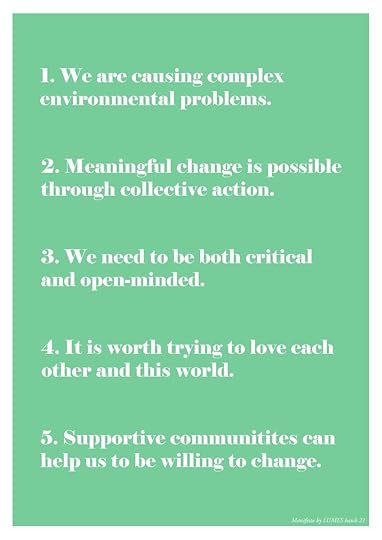 a.image2.image-link.image2-434-306 { padding-bottom: 141.50943396226415%; padding-bottom: min(141.50943396226415%, 433.0188679245283px); width: 100%; height: 0; } a.image2.image-link.image2-434-306 img { max-width: 306px; max-height: 433.0188679245283px; } Manifesto by Lund University Master’s Students in Environmental Studies and Sustainability Science (LUMES), 2019
a.image2.image-link.image2-434-306 { padding-bottom: 141.50943396226415%; padding-bottom: min(141.50943396226415%, 433.0188679245283px); width: 100%; height: 0; } a.image2.image-link.image2-434-306 img { max-width: 306px; max-height: 433.0188679245283px; } Manifesto by Lund University Master’s Students in Environmental Studies and Sustainability Science (LUMES), 2019 Possible actions to find and connect with your Climate Peeps:
Who do you already know and like who cares about climate? Is there someone at work who’s suggested revising your office travel policy to eliminate unnecessary flights? Do you have a friend who posts about climate on social media? Reach out to that person and make a climate date. Send them this newsletter if you need a conversation starter.
Host a climate book club (fiction, nonfiction, graphic novels, …). (Readers contributed wonderful discussion questions for Under the Sky We Make.)
Craft something about climate change, like these awesome knitters.
 Josie George @porridgebrainI decided that this year, every day, I would knit a row on a scarf to mark the corresponding daily temperature/weather of my town. It felt like a good way to engage with the changing climate and with the changing year. A way to notice and not look away. Here's January then.
Josie George @porridgebrainI decided that this year, every day, I would knit a row on a scarf to mark the corresponding daily temperature/weather of my town. It felt like a good way to engage with the changing climate and with the changing year. A way to notice and not look away. Here's January then. 
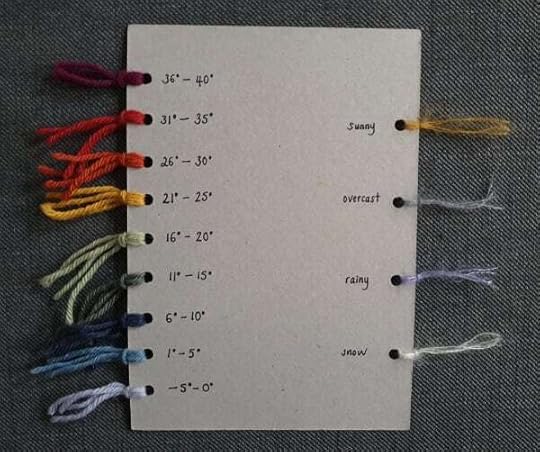
February 2nd 2020
52,196 Retweets355,416 LikesWriter Sofia Benoit has a friend she thanks for “freaking out about climate change with me on Mondays and Wednesdays.” Maybe you need a designated climate freakout time and buddy!?
Find a local group of human beings who are already doing climate work in an area you care about— your school, your neighborhood, on an issue that moves you. There are climate groups in every part of the world, and for every approach, so you might have to audition a few to find the right fit. Join their next meeting and see if you like the vibe. If you do, start figuring out how you can make yourself useful to the group. I promise you have skills that they need.
Find an online tribe. Talk Climate To Me is doing great work for women in Toronto. Every social media platform has climate channels, accounts, hashtags, communities.
I’d like to make We Can Fix It more of a community, where subscribers can talk with each other— you are an amazing group! Would you join a discussion thread, where I email out a short question that all can discuss?
Let me know in the comments, or by replying to this email, how you’d like to see this community evolve, what would make you feel supported, and please share your success stories for building your climate community!
Parting Thoughts and TidbitsKim on the Interwebs:I got sassy on a podcast about promoting alternative proteins:
Recently Enjoyed:“I’m getting quite tired of …toxic positivity as a mantra enforced without evidence in climate circles.” - me on Sustainable Food Tech podcast.
Read: A Children’s Bible, by Lydia Millet. I devoured this incredible novel in a day and a half on vacation, and wanted to re-read it immediately upon finishing. It is so smart and unflinching and like no climate fiction I’ve read before. The Washington Post calls it “a blistering classic.”
Eat: This Hasselback al Forno by Jamie Oliver was a great Sunday roast, especially when I finally realized that the convection setting is key to getting roast veg crispy (thank you Maja!). Every recipe we’ve made from the cookbook that Miranda gave us, Jamie Oliver’s Ultimate Veg, has been a winner!
 a.image2.image-link.image2-407-610 { padding-bottom: 66.62087912087912%; padding-bottom: min(66.62087912087912%, 406.3873626373626px); width: 100%; height: 0; } a.image2.image-link.image2-407-610 img { max-width: 610px; max-height: 406.3873626373626px; } One of these versions was prepared by a professional chef with a food stylist, and one by me, guess which! (Credit: me/ Jamie Oliver)
a.image2.image-link.image2-407-610 { padding-bottom: 66.62087912087912%; padding-bottom: min(66.62087912087912%, 406.3873626373626px); width: 100%; height: 0; } a.image2.image-link.image2-407-610 img { max-width: 610px; max-height: 406.3873626373626px; } One of these versions was prepared by a professional chef with a food stylist, and one by me, guess which! (Credit: me/ Jamie Oliver) Move: I was excited to hit the Century Club (100 classes) on Peloton Yoga this week! Simon and I did a live class with Ross Rayburn to celebrate. Only slightly bummed that the people who got shout-outs were celebrating milestones of 400 classes and up (!!). Oh well, guess I’ll have to content myself with the physical and mental well-being sans social recognition. I’m @UnderSkyWeMake if you want to find me there.
July 1, 2021
"Pre-fire dread"; phase out fossils fast, fairly, and forever
Hi friends, welcome (back) to We Can Fix It, where we do the climate work the world needs by linking facts, feelings, and action. I’m your friendly neighborhood climate scientist, Kim Nicholas.
I know some of you are suffering in extreme heat or tinderbox fire conditions made worse by climate heating right now. Please take good care of your neighbors, and yourselves. It’s painful and scary to see scientific predictions of harm unfolding in the real world. It’s all the more reason to be here for each other, and to do the work. <3
 a.image2.image-link.image2-1092-1456 { padding-bottom: 75%; padding-bottom: min(75%, 1092px); width: 100%; height: 0; } a.image2.image-link.image2-1092-1456 img { max-width: 1456px; max-height: 1092px; } Hottest summer 2021 trend: hammock time + inspiration to tackle climate crisisFacts:
a.image2.image-link.image2-1092-1456 { padding-bottom: 75%; padding-bottom: min(75%, 1092px); width: 100%; height: 0; } a.image2.image-link.image2-1092-1456 img { max-width: 1456px; max-height: 1092px; } Hottest summer 2021 trend: hammock time + inspiration to tackle climate crisisFacts: Climate change isn’t fair.
In previous issues of We Can Fix It, we’ve looked at different actors shirking climate responsibility, like businesses greenwashing (or actively promoting disinformation), and governments passing delusional policies.
Today I want to turn an uncomfortable lens on another group that’s not stepping up to take climate responsibility nearly fast enough: rich people like me.
If you earn over $38,000 a year, you are rich by global standards; you’re in the top 10% of the world. This group causes about half of all household climate pollution. The bottom 50% of the population causes 7% of climate pollution. (I told you it wasn’t fair!)
In the United States, the median household lives on about $69,000 a year, with climate pollution around 16 tons per person.
Our carbon budget to limit warming to 1.5°C, and avoid the scariest impacts of climate heating in line with the Paris Agreement, is around 2.5 tons per person per year globally.
Meanwhile, US households with income above $201,000 are in the top 10% of Americans, and emit an average of 50 tons per person per year. Twenty times over the sustainable limit!
To stop climate change, we have to make a fast, fair transition to a zero-carbon society. This will take collective and political action to put policies, infrastructure, tech, and incentives in place so that everyone can meet their needs for comfortable housing, clean water, health care, education, electricity to power washing machines and fridges and smartphones, transit, etc. without causing climate change.
Yes, AND: to stop climate change, we also have to tackle overconsumption by high emitters.
Scientists have been saying this for a long time, and the world is starting to listen. The Financial Times Wealth editor Stefan Wagstyl recently focused on the high emissions from the rich, writing, “What is needed are cuts in consumption, especially the lavish sort that produces both a lot of carbon dioxide and unwanted headlines.”
Here’s what this means for you:
If your personal climate pollution is near the average for your country (or below!), there’s not much low-hanging fruit for you to reduce your own emissions. Focus your climate energy on helping cut emissions in your workplace, neighborhood, city, and country. Low-income and marginalized groups aren’t the ones who need to make lifestyle changes.
The higher your income, the more likely you are emitting a lot more than your fair share, and the more you need to work on reducing your personal footprint, in addition to working at other levels. The rich need to get to work.
You can take a carbon footprint calculator (this one is the most science-based; this one is the prettiest and most actionable) to see how far above the 2.5 ton limit you are.
Seth Wynes and I found that, across countries and conditions, the highest-impact actions that cut climate pollution fast are to go flight, car, and meat-free. Any cuts you can make in those three domains will make a big difference.
The higher your emissions, the more you need to focus on reducing your hypermobility: flying and driving all over the place, especially long distances. Air and car travel makes up the biggest share of climate pollution for high emitters, as you can see in this graph:
 a.image2.image-link.image2-900-1456 { padding-bottom: 61.81318681318682%; padding-bottom: min(61.81318681318682%, 900px); width: 100%; height: 0; } a.image2.image-link.image2-900-1456 img { max-width: 1456px; max-height: 900px; } Source: The unequal distribution of household carbon footprints in Europe, Ivanova & Wood 2020. (Red annotations added by me.)
a.image2.image-link.image2-900-1456 { padding-bottom: 61.81318681318682%; padding-bottom: min(61.81318681318682%, 900px); width: 100%; height: 0; } a.image2.image-link.image2-900-1456 img { max-width: 1456px; max-height: 900px; } Source: The unequal distribution of household carbon footprints in Europe, Ivanova & Wood 2020. (Red annotations added by me.) Flying is globally rare, and even in countries like the US and UK, most people don’t fly. But a few frequent flyers (1% of the global population) cause half of air travel emissions. Flying dominates the climate pollution of high-income folks (purple bar above).
You can reduce WAY more climate pollution from reducing your frequent flights and driving than from any other personal actions. Compare the size of the pudgy purple and pink bars above (planes and cars) with the much smaller ones for manufactured products (turquoise) or clothing (green).
So if you’re trying to cut your own emissions, spend your time planning a flight-free holiday (big carbon savings!) instead of obsessing over compostable toothbrushes (tiny carbon savings!).
You can’t recycle your way out of flight pollution: You’d have to avoid 10,000 plastic water bottles (one a day for over 27 years) to equal the emissions from just one roundtrip flight from London to New York.
For the average household in the US or Europe, gasoline for cars is the biggest climate polluter (pink bar above). Note that a top 10% polluter in Europe drives 2.5 times more than someone in the middle; a top 1% polluter drives 4 times more. Go car-free, or reduce driving as much as you can, and work towards car-free cities and societies.
A plant-based diet is the highest-impact climate action for food, and a big win for biodiversity and health. We must reduce meat consumption to limit warming to 2°C or less. Yay plants!
BUT: emissions from food consumption are a relatively small part of personal footprints, and they don’t increase that much with income (blue bar above). So if you’re a vegan + a frequent flyer, the climate math is not on your side. Sorry!
Feelings: Pre-Fire DreadI had the chance to talk with Dr. Britt Wray, Human and Planetary Health Fellow at Stanford University and author of the wonderful Gen Dread newsletter about staying sane in the climate and wider ecological crisis. We talked about my professional transition from nature nerd to waging existential battle, and coping with the feeling of “pre-fire dread”, as the fire journalist Sarah Stierch put it on Twitter last month.
Here’s an excerpt from our conversation:
Britt: What do you think can be done within scientific circles to create more open, holistic and inclusive conversations about emotions and environmental decay?
Kim: Young people now are very much aware of the crisis and emergency nature of the situation and that attracts a different kind of person, for different reasons. I got into this stuff because I thought it was fun to hike around in nature and look at plants. I didn’t realize that I was signing up for this existential battle for the future of humanity against this extremely well-organized and powerful set of entrenched interests. But I think people going into the field now do know that more. I think we could learn a lot from them.
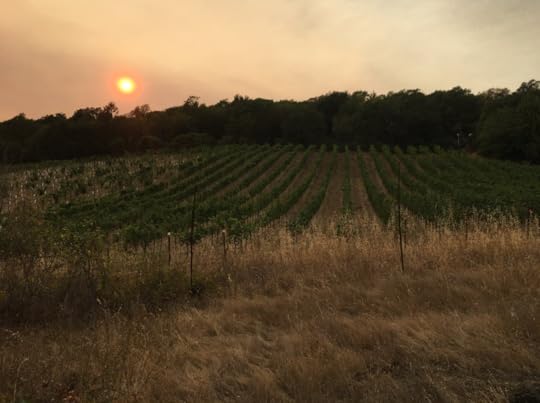 a.image2.image-link.image2-1087-1456 { padding-bottom: 74.6565934065934%; padding-bottom: min(74.6565934065934%, 1087px); width: 100%; height: 0; } a.image2.image-link.image2-1087-1456 img { max-width: 1456px; max-height: 1087px; } Sunset through wildfire smoke over vineyards in my beloved Sonoma, California last summer. Photo by me.
a.image2.image-link.image2-1087-1456 { padding-bottom: 74.6565934065934%; padding-bottom: min(74.6565934065934%, 1087px); width: 100%; height: 0; } a.image2.image-link.image2-1087-1456 img { max-width: 1456px; max-height: 1087px; } Sunset through wildfire smoke over vineyards in my beloved Sonoma, California last summer. Photo by me.
Britt: How are you thinking about your own coping for the years ahead, given what you know you're going to have to increasingly witness?
Kim: Yeah, I am worried about that. I recognize that I have great support and I have financial and emotional and physical situations that are very privileged and shield me from a lot of the most dangerous and harmful impacts. At the same time, I think being in this line of work, the glasses through which I see world are so climate coloured, that it can be hard to turn off or hard to avoid.
Last night I was on Twitter and in a conversation among folks that I know back in Sonoma, they were talking about having this feeling of pre-fire dread. And a lot of people were relating to that idea because California is in this intense drought, and they know it's an early warning for fire season. The warnings look very bad from all over Northern California, for fires starting later this summer. It’s really scary to see a map where every place on it is red.
There’s nowhere it is actually safe. I'm not in California right now, but my family and friends are, people and places that I love are. There’s things about it that are really hard when it comes to being farther away, and then there are things that are easier because it's not my daily lived reality.
So to answer your question, I'm definitely aware it's very important to prioritize health and sleep and rest and exercise and time in nature and time with friends and things that are restorative. These are all important to maintain and they also make life more fun and meaningful and worth living. But they are also a lifeline for staying healthy and to be able to do the work.
Britt: Absolutely they are. Thanks for sharing your thoughts with me on how to do that!
Subscribe to Gen Dread to keep up with Britt’s insightful work.
Action: Support Fossil Fuel Non-ProliferationPop quiz to see if you’ve been paying attention, dear We Can Fix It reader!
Q: How much carbon pollution comes from burning fossil fuels like coal, oil, and gas?
A: Over 85% (We Can Fix It, May 2021). Fossils cause around 3/4 of all greenhouse gases; the remaining 1/4 comes from agriculture and land use (We Can Fix It, Jan 2021)
Q: What has to happen to fossil fuels if we want to stop climate breakdown?
A: Fossil fuels have to stay in the ground! (We Can Fix It, May 2021)
Q: What are governments and businesses planning to do with fossil fuels?
A: Keep burning them and making the climate crisis worse. AAAAARRGHHHH! (We Can Fix It, April 2021)
When politicians talk about climate solutions, they love to talk about clean energy, new technology, and the good jobs they’ll create. (Hooray for clean energy and good jobs!)
When businesses talk about climate solutions, they love to talk about how their current-or-very-slightly-tweaked business model is key to a clean, green future. (They’ve got shareholders to appease.)
Everyone loves to talk about investing and innovating and scaling up shiny new things! And climate policy loves to encourage cleaner stuff, like bike lanes and solar panels.
But you know what wonks and CEOs don’t like to talk about? The urgent need to stop doing dirty, polluting, unsustainable things, like finding and digging up and burning more fossil fuels.
Prof. Rebecca Willis of Lancaster University calls this “the feelgood fallacy”: while promoting good stuff, climate policy to date often fails to tackle the essential need to get to the root of the problem, and reduce fossil fuel extraction, production, and use.
To stop climate change, we can’t just cobble clean energy on top of the dirty stuff. We have to shut down the dirty stuff and its pollution (close coal mines, dismantle pipelines, stop manufacturing internal combustion engines), and entirely replace them with clean stuff (mostly electricity made with wind, water, and solar).
So this month’s action is to support policies that phase out fossil fuels fast, fairly, and forever. That’s the goal of the Fossil Fuel Non-Proliferation Treaty, which draws inspiration from the nuclear non-proliferation treaty 50 years ago. Here’s a 2 minute intro:
 a.image2.image-link.image2-770-1456 { padding-bottom: 52.88461538461539%; padding-bottom: min(52.88461538461539%, 770px); width: 100%; height: 0; } a.image2.image-link.image2-770-1456 img { max-width: 1456px; max-height: 770px; } 2 min video introducing the Fossil Fuel Non-Proliferation Treaty
a.image2.image-link.image2-770-1456 { padding-bottom: 52.88461538461539%; padding-bottom: min(52.88461538461539%, 770px); width: 100%; height: 0; } a.image2.image-link.image2-770-1456 img { max-width: 1456px; max-height: 770px; } 2 min video introducing the Fossil Fuel Non-Proliferation Treaty
The treaty wants governments to do three things by 2023:
Stop adding to the problem: End new fossil exploration and expansion. (This is non-proliferation: “the practice of curbing excessive, rapid spread”).
Get rid of the existing threat (global disarmament). Phase out existing fossil stockpiles and production, in line with 1.5°C.
Accelerate an equitable, peaceful transition. Increase access to renewable energy, and develop just transition plans for workers.
Here are a few ways you can take action:
Sign your name to call for national governments to take the steps above. Over 12,000 scientists have endorsed a #FossilTreaty (including me!).
Get your city government to pass a motion to support a #FossilFuelTreaty. The campaign has a how-to guide, from background research, to finding and meeting with a local champion for the motion, building community pressure, and following up. Read their pitch to cities (available in English, Spanish, French) and adapt their draft motion to your jurisdiction. Cities including Vancouver (Canada), Barcelona (Spain), Los Angeles (USA), Lewes (UK), and Darebin (Australia) have already endorsed a fossil treaty.
Endorse the treaty as an organization, like your local chapter of your favorite climate movement org, or a corporation.
Check out their action guide for more inspiration, including graphics, posts, and videos for social media, a guide for writing a local letter to the editor, and 17 more action ideas!
Notice and point out when media, politicians, and businesses are committing the “feelgood fallacy,” and only talking about clean alternatives without addressing the need to end both production and consumption of fossil fuels.
Parting Thoughts and TidbitsKim on the Interwebs:I joined Dr. James Dyke for a book seminar on Under the Sky We Make at the University of Exeter. We discussed my great-grandmother’s climate legacy, my climate wake-up moments, the role of academics in the climate and ecological emergencies, and more. Watch here, and reply to this email to let me know if you’d like to host a book discussion for your group!
 a.image2.image-link.image2-819-1456 { padding-bottom: 56.25%; padding-bottom: min(56.25%, 819px); width: 100%; height: 0; } a.image2.image-link.image2-819-1456 img { max-width: 1456px; max-height: 819px; } Dropping some science on the Zoom, in conversation with Dr. James Dyke at the Global Systems Institute at the University of Exeter.Recently Enjoyed:
a.image2.image-link.image2-819-1456 { padding-bottom: 56.25%; padding-bottom: min(56.25%, 819px); width: 100%; height: 0; } a.image2.image-link.image2-819-1456 img { max-width: 1456px; max-height: 819px; } Dropping some science on the Zoom, in conversation with Dr. James Dyke at the Global Systems Institute at the University of Exeter.Recently Enjoyed: Read: Too Hot to Handle? The Democratic Challenge of Climate Change, by Rebecca Willis. Do you ever worry democracies can’t handle the climate crisis? Me too. (And so does Ezra Klein.) This concise handbook reassured me that stopping climate heating requires more democracy, not less- and offers a roadmap for what that can look like in practice, based on the author’s 20+ years of research and policy experience.
Listen: My Golden Girl Lucy Kalanithi has a new podcast, Gravity, and you must listen to it immediately!! It’s intimate, raw, funny conversations with brilliant, thoughtful people talking about how they get through the hardest things. Her interview with Ady Barkan on resistance & acceptance (in his case, living with a debilitating disease) has SO much climate wisdom.
Move: I’m doing a summer Bingo of fun activities with some friends. Each day you can tick off one healthy and playful activity. I’m excited to take the kvällsdopp (evening dip, after 8pm) and morgon dopp (morning dip, before 10am) in the Baltic, and try to work up to 20 perfect pushups and a yoga handstand.
REST! I hope you’re in a place (geographically, mentally, financially, …) where you can give yourself some time to rest and restore this summer. We need it. This year I’m exercising my Swedish right to four consecutive weeks of holiday over July, starting TODAY! Thanks for your patience if you don’t hear from me during this time.
Please note there will be no newsletter at the end of July. I plan to be back with a renewed spirit in August. Take care everyone!
May 28, 2021
Don't be fossil fooled; celebrating climate victories!
Hola amigos! I’m sustainability scientist Kim Nicholas, and I’m so glad you’re back. If you’re new, welcome! Here’s your cheat sheet to get up to speed on what we’re doing here at We Can Fix It (basically: canceling the climate crisis; normally on the last Thursday of every month, but this month I had to examine masters’ theses- congrats LUMES grads!).
On the menu this month:
Facts: How to avoid being fossil-fooled by empty climate promises
Feelings: Celebrating climate wins!
Action: Break up with your climate-destroying mega-bank
How do you know if a politician or company’s climate goal is good enough?
What does a serious climate pledge need?To stop climate breakdown, we need to leave fossil fuels in the ground now. Ketan Joshi’s sketch below sums it up.
Strong climate pledges should have separate, non-tradable strategies for preventing carbon pollution in the first place (essential), and for any attempts to remove carbon from the atmosphere. (Deep dive here).
Offsets don’t work. Sorry. Serious climate policies will not keep polluting and promise to clean it up later.
Climate pledges should focus on BIG reductions of tons of carbon pollution emitted, starting THIS YEAR, compared with current emissions. Kevin Anderson and colleagues conclude countries like Sweden and the UK should be reducing carbon pollution at least 10% per year, starting now.
 Ketan Joshi @KetanJ0Please allow me to re-share my rough sketch of some advanced carbon capture technology
Ketan Joshi @KetanJ0Please allow me to re-share my rough sketch of some advanced carbon capture technology 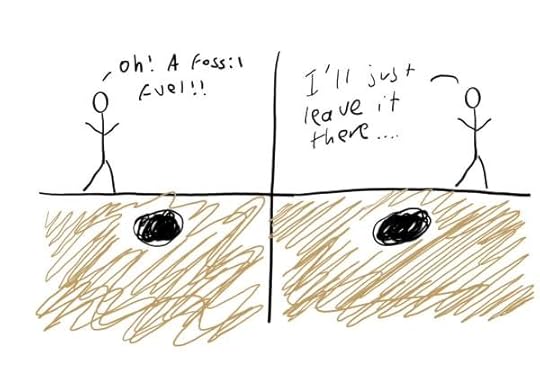
May 4th 2021
4,419 Retweets27,143 LikesWhat will it take to stop warming?Total climate warming ≈ total danger, harm, and suffering experienced by people and nature. :(
Total climate warming ≈ cumulative carbon emitted.
Therefore, cumulative carbon emitted ≈ total climate danger.
Goal of climate policy ≈ avoid danger.
Therefore goal of climate policy ≈ avoid adding carbon to the atmosphere.
When humans stop adding carbon to the atmosphere, we will have reached “net zero” carbon. This is necessary to stop warming. The faster we get there, the less the climate will warm, & the less harm and suffering.
Continuing business as usual will use up our remaining carbon budget, the total amount we can ever emit for 1.5°C, in less than 10 years. EEEK!! (So we’ve got to change business as usual.)
How do we get to net zero carbon?The best way: stop adding carbon to the atmosphere in the first place. That means, stop burning fossil fuels, which cause over 85% of carbon pollution today. (The rest comes from deforestation.) Preventing emissions in the first place is “real zero,” and should be the primary goal of climate pledges and plans. It’s necessary for energy to reach real zero emissions. (We’ll tackle agriculture in a later post.)
The worst way: continue business as usual (yay oil and gas!), and promise to clean up the mess using “offsets”: removing as much carbon from the atmosphere as you added (where, when, how is often a bit vague).
In practice, offsets don’t work. Sorry!
Tree-planting for carbon schemes often fails to benefit local communities, or even backfires and creates more carbon pollution than it takes up, like California’s forest offset program. There will never be enough trees to offset fossil fuels.
Carbon removal tech is the great hope of fossil fuel companies, because it would enable them to continue producing and selling their current products. But climate gurus Kevin Anderson and Glen Peters call carbon removal tech “an unjust and high-stakes gamble.”
Will the necessary emissions cuts be easy?No.
For a pretty good (2 in 3 chance) of limiting warming to 1.5°C, we should be aiming for cutting carbon emissions more than half globally by 2030, and nearly eliminating them by 2040, like the eye-popping rate in this graph:
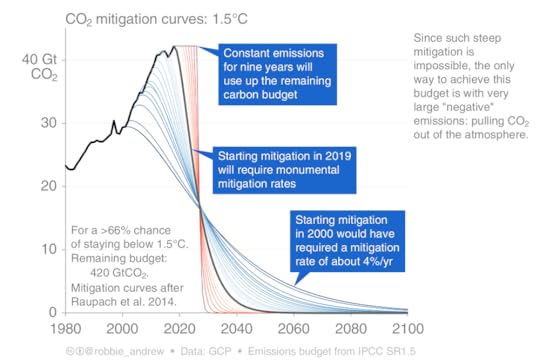 a.image2.image-link.image2-667-1000 { padding-bottom: 66.7%; padding-bottom: min(66.7%, 667px); width: 100%; height: 0; } a.image2.image-link.image2-667-1000 img { max-width: 1000px; max-height: 667px; } Source: @robbie_andrew in James Dyke et al., 2021, The Conversation
a.image2.image-link.image2-667-1000 { padding-bottom: 66.7%; padding-bottom: min(66.7%, 667px); width: 100%; height: 0; } a.image2.image-link.image2-667-1000 img { max-width: 1000px; max-height: 667px; } Source: @robbie_andrew in James Dyke et al., 2021, The ConversationThe longer we delay, the harder the challenge to reduce emissions fast enough. It would have been a lot easier if we’d started earlier. But we gotta start now.
It’s tempting to avoid making tough emissions cuts by promising to remove the carbon from the atmosphere instead. But in practice, the potential to increase carbon removals from the atmosphere is very limited. Over-reliance on increasingly absurd and unrealistic promises of future carbon removal led climate researchers to call the concept of net zero “a dangerous trap” (recommended reading!).
What does this mean for business as usual?One conversation we should be having is: what should happen to fossil fuel companies, now that their products need to be abandoned ASAP?
Should fossil fuel companies die a managed death, while workers are fairly transitioned into new jobs? Or should they transform into something else (non-fossil energy companies)? (From a conversation led by Johan Gardebo this week).
Discuss!!
Feelings: Celebrating Climate Victories!This has been an exceptionally good week for climate news, so I thought I’d share some VERY well-deserved celebrations by a bunch of hard-working people around the world.
First, the big news from the Netherlands: for the first time globally, a company is being held legally liable for its contribution to climate change, and held responsible for meeting its share of the Paris Agreement. The Dutch court ruled that Royal Dutch Shell’s weak-sauce climate plan (keep burning fossils but plant trees!) and tired excuses were, respectively, weak-sauce and tired. The ruling means Shell will have to actually reduce emissions, to the extent that Shell will have to “reconsider its fossil fuel production plans,” (AKA leave it in the ground), according to climate law professor Harro van Asselt.
To dive into the details of the decision, put it in context, and see what happens next, check out Ketan Joshi’s Twitter thread, especially on the judge’s rebuttals to hackneyed claims like “if we don’t produce oil, someone else will.”
But here I wanted to focus on celebrating the far-too-rare, fleeting, but still magical feeling of actually WINNING a climate victory that a small group has worked at for years, against seemingly impossible odds. Look how pumped these folks from Friends of the Earth Netherlands, who brought the case to court, are!!
 a.image2.image-link.image2-341-1024 { padding-bottom: 33.30078125%; padding-bottom: min(33.30078125%, 341px); width: 100%; height: 0; } a.image2.image-link.image2-341-1024 img { max-width: 1024px; max-height: 341px; } Photo: Milieudefensie / Friends of the Earth Netherlands
a.image2.image-link.image2-341-1024 { padding-bottom: 33.30078125%; padding-bottom: min(33.30078125%, 341px); width: 100%; height: 0; } a.image2.image-link.image2-341-1024 img { max-width: 1024px; max-height: 341px; } Photo: Milieudefensie / Friends of the Earth Netherlands a.image2.image-link.image2-800-1200 { padding-bottom: 66.66666666666666%; padding-bottom: min(66.66666666666666%, 800px); width: 100%; height: 0; } a.image2.image-link.image2-800-1200 img { max-width: 1200px; max-height: 800px; } Milieudefensie director Donald Pols (right) celebrates the verdict. Photo: Peter Dejong/AP
a.image2.image-link.image2-800-1200 { padding-bottom: 66.66666666666666%; padding-bottom: min(66.66666666666666%, 800px); width: 100%; height: 0; } a.image2.image-link.image2-800-1200 img { max-width: 1200px; max-height: 800px; } Milieudefensie director Donald Pols (right) celebrates the verdict. Photo: Peter Dejong/API wanted to offer my gratitude for all the people who played a role in making this moment happen. This is your victory. Thank you, and please keep fighting!
The six other organizations and 17,000 citizens who were part of the legal action.
The climate movement of millions, organizing and shaping hearts and minds through campaigning and public pressure, that supported and galvanized those folks to join the case. (You’re supporting your favorite climate orgs, right??)
All the people behind the hundreds of climate lawsuits around the world, paving the way for legal climate responsibility. Especially the Urgenda climate case, also in the Netherlands, which forced the Dutch government to reduce emissions immediately.
The thousands of policy wonks who worked for their entire careers on the Paris Agreement, which is the first reference cited in the Dutch judge’s decision.
The thousands of scientists who have contributed to reports and studies cited as a basis for the judge’s decision, including the landmark IPCC 1.5°report and the Production Gap report, among others. Climate nerds FTW!
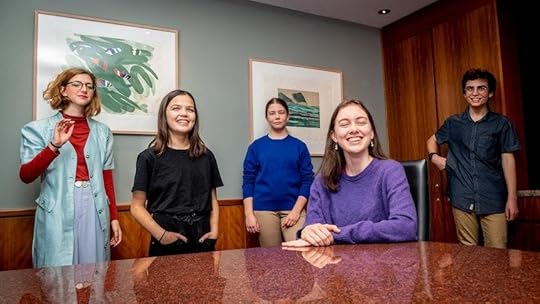 a.image2.image-link.image2-485-862 { padding-bottom: 56.264501160092806%; padding-bottom: min(56.264501160092806%, 485px); width: 100%; height: 0; } a.image2.image-link.image2-485-862 img { max-width: 862px; max-height: 485px; } Teenagers in the class action case “on behalf of young Australians everywhere.” Photo: Brendan Esposito, ABC News
a.image2.image-link.image2-485-862 { padding-bottom: 56.264501160092806%; padding-bottom: min(56.264501160092806%, 485px); width: 100%; height: 0; } a.image2.image-link.image2-485-862 img { max-width: 862px; max-height: 485px; } Teenagers in the class action case “on behalf of young Australians everywhere.” Photo: Brendan Esposito, ABC NewsSpeaking of climate victories: Huge congrats to eight Australian teenagers (and the octogenarian nun!), who got a judge to rule that governments should not stand idly by, locking in a world where 1 million of today’s Australian kids will require hospitalization for heat stress. (AKA, the environment minister has a duty of care to protect young people from future climate harm.) The judgment stopped short of actually stopping approval of a proposed expansion by Whitehaven Coal in New South Wales; the government is now “considering the judgment.”
Science has long shown that we have to entirely stop digging up fossil fuels, and indeed shut some existing coal plants down early, to limit warming to 1.5°C. The need to end fossil investments and expansion was recently confirmed by the International Energy Agency, a group founded in 1974 to ensure oil supply security. The times, they are a-changin’.
Action: Break Up with Your Mega-BankQuick, grab your bank card and your credit card. Whose logo is in the corner?
Bad news: if your bank or credit card company are household names, they’re massive funders of climate destruction. They lend money to coal mines, pipelines, and tar sands, and the companies that expand them.
Five years after the Paris Agreement, banks still invested over $750 billion in 2020 in projects like companies drilling in the Arctic National Wildlife Refuge and fracking in Patagonia, according to the latest Banking on Climate Chaos report.
Just a few of the banks still funding fossils, long past their best before date: JPMorgan Chase, Citi, Wells Fargo, Bank of America, Barclays, TD, BNP Paribas, Scotiabank, HSBC, Bank of China, Credit Suisse, Deutsche Bank, UBS, Danske Bank, Nordea (Lund University’s default bank, ahem)…. look familiar? (If you don’t see your megabank, check the full list… it’s probably on there!)
Stop giving these guys your money.
Let them know why you’re leaving them (and encouraging your friends to do the same).
Switch to a credit union (a member- based, nonprofit, primarily local financial cooperative that returns income to members in the form of lower fees, as opposed to paying profits to investors).
I switched from Bank of America to Redwood Credit Union in Sonoma, and in Sweden, I switched from Nordea to Sparbanken Skåne in Lund. I’ve been happy in both cases with vastly better customer service, and a clearer conscience. (Ekobanken gets an even better environmental rating from Fair Finance Guide in Sweden, but when I was switching, they lacked some key features I required like autogiro and a debit card, so it didn’t work for me.)
I suffered from analysis paralysis with switching banks, but once I decided to do it, switching was less of a pain in the ass than I’d expected. It actually felt good to do a bit of an audit, cancel some old subscriptions I didn’t need any more and hadn’t realized I was still paying, and set up some basic adulting things like savings and investment accounts with monthly auto-transfers.
You can do it! Look for a local credit union (sparbanken in Sweden), check out the Fair Finance Guide for recommendations in 13 countries, and make the switch.
Feel free to reuse or adapt the letter I wrote to break up with BofA, and/or this template from Ethical Consumer.
Share your bank breakup on social media and with friends and colleagues to help inspire them too.
Parting Thoughts & TidbitsKim on the Internet: Finally, someone asks me about masturbating turkeys
I got to talk to Michael Osborne about mutual friends, how much are individuals really responsible for climate change, and my family’s legacy in turkey masturbation. (That’s how I knew he had really read Under the Sky We Make!) Enjoy:
Kim on Newsstands:
I talked with Richard Webb at New Scientist about climate work as a crucible to create meaning, what I lose sleep over, and Tindering while climate-conscious “without becoming an insufferable bore and turn-off,” as he put it. Read here (subscription required), or pick up a real magazine at a real newsstand!
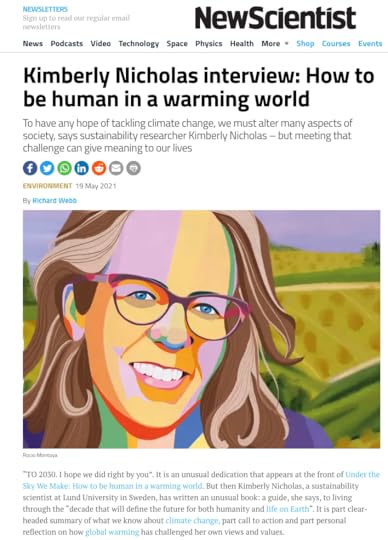 a.image2.image-link.image2-453-325 { padding-bottom: 139.0995260663507%; padding-bottom: min(139.0995260663507%, 452.0734597156398px); width: 100%; height: 0; } a.image2.image-link.image2-453-325 img { max-width: 325px; max-height: 452.0734597156398px; } Source: New Scientist. Artwork by Rocio Montoya.
a.image2.image-link.image2-453-325 { padding-bottom: 139.0995260663507%; padding-bottom: min(139.0995260663507%, 452.0734597156398px); width: 100%; height: 0; } a.image2.image-link.image2-453-325 img { max-width: 325px; max-height: 452.0734597156398px; } Source: New Scientist. Artwork by Rocio Montoya. Recently Enjoyed:
Read: Probably the best climate writer out there, IMO, is Elizabeth Kolbert. Her writing for The New Yorker is just stunning. Her recent book, Under a White Sky (great title, right?!), is beautifully written and uncomfortable, examining the increasingly crazy ways man is trying and usually failing to control nature.
Eat: Simon and I finally defrosted our freezer, which gave rise to the Challenge Ingredient Cook-Off, where we wrangled a lot of mystery items we’d forgotten about into dinner form. During my week to cook, I made yummy potato skins and bizarre glutinous dumplings. See what you can rustle up from forgotten corners of your kitchen before it goes off, saving some food waste and cash. :)
Grow: All our plant babies (seedlings we started indoors back in February) are safely in the ground at the allotment garden, and we planted our perennial food forest with the help of Atticus, Pili, Laura, and Mike a few weeks ago (tack vänner!). Pics next time. Bye!
April 29, 2021
Voting Conservative triples your carbon footprint
Hi friends! Thanks for being part of the We Can Fix It community.
Welcome new subscribers; there are a lot of you, yay! We’ve already grown to over 1,000 members since we launched exactly three months ago. You can get a refresher on my not-so-secret mission to empower and inspire meaningful climate action here.
Everyone, please keep spreading the climate-fixin’ love and share this newsletter with folks who are into a thriving planet that works for people and nature. Thank you!
As always, I love to hear your feedback and questions. You can reply to this email or hit the contact button below to reach me.
On to the facts, feelings, and action!
Facts: Vote Conservative, triple your carbon footprintClimate has been on the ballot in many recent elections, like the US in 2016 and 2020, Brazil in 2018, and Canada and the UK in 2019, due to big differences in climate policies between major parties. But what’s the climate impact of voting?
Activists claim that voting is a highly effective climate action; so do Members of Parliament. But still, many citizens don’t feel that their vote makes a difference for the climate.
A new study has quantified how much an individual voter can influence climate pollution, and it’s HUGE.
For example, if you voted in the 2019 Canadian election for Justin Trudeau’s winning Liberal party, the researchers calculated your vote saved 34.2 tons of climate pollution per year. That’s like taking 14 typical gas cars off the road.
Conversely, if instead the Conservative party of Canada had won, their voters would have effectively tripled their carbon footprints overnight.
Please consider: these huge emissions reductions per voter are for climate policies that are still pretty weak sauce, and FAR short of what’s needed. The emissions reductions from the Liberal party’s policies in Canada were modeled at about 1.2% per year; we need about 8% reductions per year globally, and up to 10% per year in rich countries like the UK, to meet the Paris Agreement goal of limiting warming to 1.5°C. Imagine what we could do with big-time climate policy!!
This striking research was led by the brilliant Seth Wynes (my former student and We Can Fix It reader- hi Seth!).
Another important insight from the study: if you have money to spend on climate action, don’t buy offsets. Donate it to politicians running on a strong climate platform, especially supporting scrappy challengers against incumbents with a bad climate voting record early in the election cycle in close races.
A good option for non-wonks who don’t follow every race is “giving to organizations who aim to elect climate-concerned legislators and relying on their expertise to allocate funding.” (In the US, SwingLeft lets you donate to close races in your area of interest, like Environment). Wherever you give, openly discussing your contributions is important, because research shows this type of giving is contagious.
How do you measure the climate impact of voting??There are well-established methods from life-cycle analysis to count the emissions from driving a car or buying a pair of jeans. But Seth and colleagues had to get creative to develop a method for counting the carbon impact from voting.
They come up with several possible methods. They call my favorite one “emissions responsibility,” specifically the “winning voters” flavor. This approach calculates the difference in climate pollution that would result between the climate policies of the major candidates during the time they’re in power. The increase or decrease in emissions resulting from the winning party’s policies are divided over each winning voter who supported them. Here’s how it worked in the example of the 2019 election in Canada:
 a.image2.image-link.image2-840-1456 { padding-bottom: 57.692307692307686%; padding-bottom: min(57.692307692307686%, 840px); width: 100%; height: 0; } a.image2.image-link.image2-840-1456 img { max-width: 1456px; max-height: 840px; } Counting votes & carbon. Source: Wynes et al., 2021, One Earth. Please vote for climate!
a.image2.image-link.image2-840-1456 { padding-bottom: 57.692307692307686%; padding-bottom: min(57.692307692307686%, 840px); width: 100%; height: 0; } a.image2.image-link.image2-840-1456 img { max-width: 1456px; max-height: 840px; } Counting votes & carbon. Source: Wynes et al., 2021, One Earth. Please vote for climate! Another key finding: registering to vote (and actually voting) is super important for the climate!! I was struck by the figure showing that only about 2/3 of the population is registered to vote, and only half of the population actually votes, in the 10 large democracies the authors consider. They write, “If we calculate emissions per voter instead of emissions per capita, each voter takes on roughly twice the responsibility, since the emissions that we previously attributed to adolescents or the disenfranchised are now assigned to those with political agency.” Check out the figure below. And get thee (and others) registered and to your ballot when there’s an election!
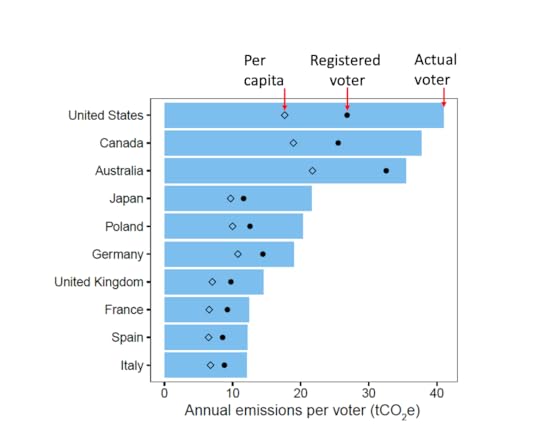 a.image2.image-link.image2-967-1168 { padding-bottom: 82.79109589041096%; padding-bottom: min(82.79109589041096%, 967px); width: 100%; height: 0; } a.image2.image-link.image2-967-1168 img { max-width: 1168px; max-height: 967px; } Dividing climate pollution per voter instead of per capita: political agency comes with more climate responsibility. Source: Wynes et al., 2021, One Earth
a.image2.image-link.image2-967-1168 { padding-bottom: 82.79109589041096%; padding-bottom: min(82.79109589041096%, 967px); width: 100%; height: 0; } a.image2.image-link.image2-967-1168 img { max-width: 1168px; max-height: 967px; } Dividing climate pollution per voter instead of per capita: political agency comes with more climate responsibility. Source: Wynes et al., 2021, One EarthSo does this mean a Liberal voter in Canada can go out and buy 14 cars with a clean conscience?? I asked Seth how citizens should think about their climate emissions from lifestyles vs. voting. He said, “I would think of your lifestyle emissions as your carbon footprint and your political actions as a carbon handprint. If you volunteer at a soup kitchen you wouldn’t use that as an excuse to not cook a meal for your family but they are both good things to do.” So high emitters aren’t off the hook for reducing our overconsumption, but everybody eligible should vote.
Feelings: Fed Up with GreenwashingIn case you managed to avoid the Internet last Thursday (if so- I salute you!! What is your secret??), you know that it was Earth Day.
I love the Earth, but I hate Earth Day.
I wrote an essay partly excerpted from my new book Under the Sky We Make (have you ordered your copy yet??) about my frustration with Earth Day, and what I want us to do to be able to give the Earth the celebration she deserves. Here’s a peek; the full piece is online here.
 a.image2.image-link.image2-819-1024 { padding-bottom: 79.98046875%; padding-bottom: min(79.98046875%, 819px); width: 100%; height: 0; } a.image2.image-link.image2-819-1024 img { max-width: 1024px; max-height: 819px; } Lovely illustration from Andy Carter, from a DeSmog story on greenwashing.
a.image2.image-link.image2-819-1024 { padding-bottom: 79.98046875%; padding-bottom: min(79.98046875%, 819px); width: 100%; height: 0; } a.image2.image-link.image2-819-1024 img { max-width: 1024px; max-height: 819px; } Lovely illustration from Andy Carter, from a DeSmog story on greenwashing.
I’m an environmental scientist, and I hate Earth Day.
I roll my eyes at the sudden scramble for 24 hours’ worth of eco-content and scoff at the light green veneer painted over business as usual.
But most of all, I am furious that, every year, April 22 comes and goes while we continue to dig ourselves deeper towards climate and ecological debt and disaster.
Since the first Earth Day in 1970, humans have used up almost 70% of the carbon budget available for all of time, for all of humanity, pushing us towards the brink of climate catastrophe. No one born after 1985 has lived through a normal year on planet Earth; every year of their lives has been warmer than the twentieth- century average.
Wild vertebrate populations have declined 68 percent since Earth Day began. It will take millions of years for evolution to recover the biodiversity that has already been lost. Life on Earth is on life support: Humans are now driving species to extinction at a rate one thousand times faster than natural. Human exploitation of nature, primarily from land use and agriculture, is unraveling the web of life, which ultimately includes us.
I am heartbroken by the worries weighing on young people two generations after Earth Day began. At a climate protest in 2014, I listened to an eight-year-old girl deliver a powerful speech: “I dream of studying the ocean, but I’m afraid the ocean may be dead when I grow up.”
As a scientist, I’m terrified that she may be right. Half of live coral cover on coral reefs, which buffer storms and are nurseries to much of the life in the oceans, has already died.
And I’m furious at the impotence of data and knowledge, because we’ve known since before I was born what the problem is, and what we have to do.
Five years before the first Earth Day, the president of the American Petroleum Institute warned of the “catastrophic consequences of pollution” and looming “marked changes in climate… caused by … the burning of coal, oil, and natural gas.”
That was in 1965. Before we put a man on the freaking moon.
For my entire career, and for more than my entire life, far too many business, government, media, and cultural leaders have either ignored or actively denied climate reality, and either marginalized or threatened the scientists who gave it voice. Meanwhile, amid these decades of deliberately manufactured doubt and delay, fossil fuel emissions have tripled since the industry’s own 1965 warning of catastrophic consequences.
We can do better than these last decades, and turn things around. I have a plan for how we should celebrate Earth Day for reals; read it here.
Action: Hot Date with Planet EarthYour action this month is to make a date with the planet for you and your loved ones. Catch up on quality time in your community garden or your local park or beach.
The average American child spends seven hours a day on a screen, and seven minutes or less playing outside. :(
Humans need a personal, physical connection to natural places to feel our most alive and grounded. Studies show that direct, repeated experiences with local nature over time is how people, especially children, build a relationship with nature and a sense of place and feel a connection and responsibility as well as agency to protect nature.
 a.image2.image-link.image2-1436-1440 { padding-bottom: 99.72222222222223%; padding-bottom: min(99.72222222222223%, 1436px); width: 100%; height: 0; } a.image2.image-link.image2-1436-1440 img { max-width: 1440px; max-height: 1436px; } Out for a walk near Simrishamn last week. Photo: me
a.image2.image-link.image2-1436-1440 { padding-bottom: 99.72222222222223%; padding-bottom: min(99.72222222222223%, 1436px); width: 100%; height: 0; } a.image2.image-link.image2-1436-1440 img { max-width: 1440px; max-height: 1436px; } Out for a walk near Simrishamn last week. Photo: meSome Actions to get you out enjoying and taking care of your local patch:
Sit quietly in nature for 5 or 10 minutes and simply observe your surroundings. What can you see, hear, smell, and feel? This doesn’t have to be somewhere exotic; it can be right outside your front door. More than 30 years later, I still vividly remember watching an ant crawl up a sunlit blade of grass on the front lawn of my school for a fourth-grade science assignment.
Get in the habit of leaving nature better than you found it. I try to carry a trash bag with me to pick up litter when I’m out for a walk. For mega inspiration, check out the #EarthCleanUp by Edgar McGregor. With daily effort and a bucket over a year and a half, he completely cleaned up one of the most popular hiking trails in Los Angeles. This 90 second video is an inspiring watch. Another inspiration is 12-year-old Lilly of Lilly’s Plastic Pickup; here’s her story. (Btw, I learned a lot about litter psychology, gentrification, and community from this Eve Andrews piece, “How do I get my neighbors to stop littering?”)
Get to know the nature in your own backyard. The author and naturalist Stephen Moss saw nearly 100 bird species within a mile of his home over the first year of the pandemic. The Low-Carbon Birding initiative promotes enjoying your feathered friends in your local patch. My friend Hakim leads free birding walks for beginners around Malmö, Sweden every Saturday with Birding Therapy.
Learn more about your local nature. Check out books like Anna Wilson’s sweet nature almanac for kids, the great Collins Garden Birdwatcher’s Bible (European birds), and the amazing, free Cornell Labs app Merlin Bird ID. To get help with ID and contribute your observations of plants, animals, and fungi to researchers, the crowdsourced app iNaturalist is wonderful.
Support your local parks and natural areas. Simon and I are members in the Friends of the Lund Botanical Garden where we take a lunchtime walk most days. Your local, state, or regional parks are mostly run by volunteers who would love your time and financial support.
Support organizations who protect, restore, and promote responsible enjoyment of nature. Among other groups, I support the conservation groups Sonoma Ecology Center and the Swedish Society for Nature Conservation (they also offer local hikes and activities), and the Swedish Tourist Association who run an amazing set of huts and hostels from which to enjoy the outdoors.
Parting Thoughts & TidbitsKim on the Internet: Talking about babies and climate
I had the chance to talk with the very smart Sigal Samuel for Vox’s Future Perfect podcast. The ostensible topics was the ethics of kids and climate change: the climate impact of creating a new person, and concerns about the life that new person might have on our warming planet. But we went way beyond that; this was one of the most wide-ranging, in-depth, and thoughtful interviews I’ve done. Have a listen (or read the highlights).
Recently Enjoyed:
Read: Ministry for the Future, by Kim Stanley Robinson. I think this is my new favorite climate fiction. Parts are DARK (the first chapter is traumatic) but also gave me the feeling that hey, we just might make this work. I finished it three weeks before my clifi bookclub and was dying to talk about it!
Eat: It’s April, we’ve had some beautiful days, but right now it’s grey and rainy. Perfect weather for this smoky vegan chili from Kenji in NYT. Cornbread on the side if you’re ambitious (here’s an easy one from Nerdy Mamma with ingredients you already have).
Listen: My friend & We Can Fix It reader Meg recommended this 10-day meditation on eco-anxiety. It’s got some good tips on handling overwhelm & building support.
Drink: I love that New Belgium Brewing’s Fat Tire launched a terrible-tasting “Scorched Earth Ale,” made from weeds, tainted water, and other ingredients from in the world we’re trying to avoid. Let me know if you try it!
P.S. I’m excited to see all of you subscribers who signed up for the special discussion of Under the Sky We Make with me and my friends Lucy Kalanithi and Colty Tipton-Johnson this coming Sunday, May 2 at 11am California, 2pm NYC, 7pm London and 8pm here in Sweden! I’ll be sending out the Zoom link shortly.
P.P.S. If you missed the signup for the We Can Fix It version, you can still host your own bookclub, and invite me to join you for a Q&A or a book seminar!
March 25, 2021
People Lie About Why They Drive
Welcome back friends! Thank you all for being here to fix the climate crisis with facts, feelings, and action.
Speaking of fixing the climate crisis with facts, feelings, and action… I just published a whole book, Under the Sky We Make, on exactly that! Please buy it from your local bookstore or find it online here, and read it, and put it into practice. Thank you!
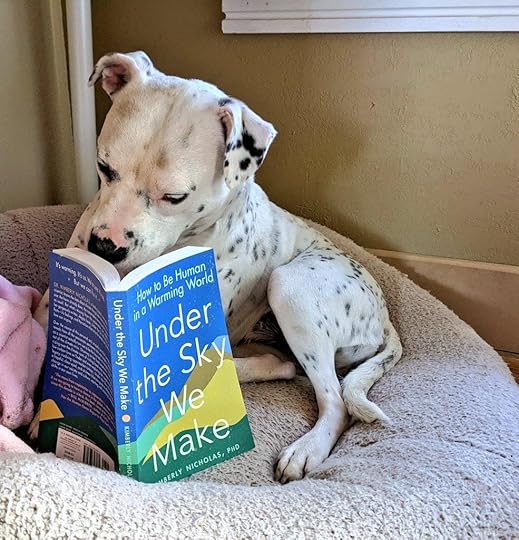 a.image2.image-link.image2-1024-985 { padding-bottom: 103.95939086294416%; padding-bottom: min(103.95939086294416%, 1024px); width: 100%; height: 0; } a.image2.image-link.image2-1024-985 img { max-width: 985px; max-height: 1024px; } Ruthie = #1 cutest reader of Under the Sky We Make (gauntlet thrown, please try to prove me wrong!). Photo: Dr. Becca Barnes
a.image2.image-link.image2-1024-985 { padding-bottom: 103.95939086294416%; padding-bottom: min(103.95939086294416%, 1024px); width: 100%; height: 0; } a.image2.image-link.image2-1024-985 img { max-width: 985px; max-height: 1024px; } Ruthie = #1 cutest reader of Under the Sky We Make (gauntlet thrown, please try to prove me wrong!). Photo: Dr. Becca BarnesAnd pretty please, send me pictures of your pets reading my book!! Thank you Becca for this wonderful pic of Ruthie! <3
OK, shameless self-promotion [temporarily] over, let’s dive in!
Facts: Shoves, Not Nudges, Change BehaviorDo you ever read a peer-reviewed study that you love so much that you highlight over half the text and exclaim out loud while reading it? Or is that just me?
In any case, that was my response to this recent study showing nudging was astoundingly ineffective to reduce driving. A bunch of #ClimateTwitter also got fired up about it.
Nudging is the idea that you can change behavior to be healthier/more eco/smarter simply by changing the decision environment, without imposing costs or requirements. For example, putting the healthiest option first in a buffet is a nudge. Banning junk food is not.
Nudging holds tantalizing promise for politicians dreaming of achieving their policy goals without pissing off constituents. For example, one study found $1 spent on nudging people to increase retirement savings offered a $100 return.
But, reality check: Ariella Kristal and Ashley Whillans from Harvard Business School found nudges were completely ineffective in changing a high-polluting behavior in the real world. Womp-womp! :/
The researchers wanted to nudge people out of driving to alone to work. So they designed experiments to give employees what they said they wanted to get them out of their cars, like info on carpooling, or cheaper transit.
But then those fickle people didn’t actually make any changes!
For example:
Nearly 15,000 employees got a letter encouraging them to sign up for their employer’s existing carpool matching service. Thirty-three signed up. A month later, there were 3 new users. :(
“Less than 1.5% of employees actually shifted their behavior when given a free bus trial or notified of subsidized bus passes.”
The researchers conclude:
“There was clearly a mismatch between what employees said they wanted and what they were able or willing to do… people’s stated barriers and future plans about their commuting behaviours may not reflect their true intentions.”
That is, people tell white lies. They might actually drive because they think their car is sexy and powerful (an image this ad, banned in France, cleverly undermines). Maybe they avoid carpooling because they don’t want to talk to people they don’t know.
In an environment where infrastructure, financial incentives, and social expectations favor driving alone to work, nudges are not enough.
What would work?The authors conclude:
“Of course, employees do not like organizations restricting choices, or taking away benefits like parking. But the long-term health and happiness of employees, and the planet, could fundamentally depend on it.”
They suggest better approaches to reduce driving:
Make the full cost of driving obvious. In the study, parking worth thousands of dollars a year was subsidized (provided for free). Either charge for parking, or pay employees a bonus equivalent to the cost of parking (and hope they choose to take the bus, and spend the cash on something more fun than parking.)
Use both carrots and sticks. Simultaneously make driving alone harder (smaller, more distant parking lots for those who drive alone), while making it easier to walk, bike, and take transit.
Change defaults. For example, only allow each employee to park at work 3 days per week, or allow remote work to reduce commutes. Help relocate employees closer to work and transit, to make it easier not to drive (“location-efficient mortgage schemes”).
Nudge strategically. Nudges work better for one-time behaviors, like getting a flu shot. For daily habits, they’re more effective during moments of change, like moving, starting a new job, or during a serious disruption. (So, implementing smart policies now could shift behavior post-pandemic.)
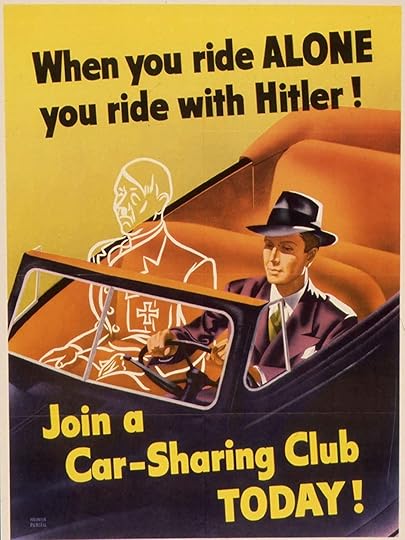 a.image2.image-link.image2-568-426 { padding-bottom: 133.33333333333331%; padding-bottom: min(133.33333333333331%, 568px); width: 100%; height: 0; } a.image2.image-link.image2-568-426 img { max-width: 426px; max-height: 568px; } A strong message against driving alone! (US government propaganda poster, 1943)Feelings: Nerds need them too
a.image2.image-link.image2-568-426 { padding-bottom: 133.33333333333331%; padding-bottom: min(133.33333333333331%, 568px); width: 100%; height: 0; } a.image2.image-link.image2-568-426 img { max-width: 426px; max-height: 568px; } A strong message against driving alone! (US government propaganda poster, 1943)Feelings: Nerds need them too This week, I was thrilled to have an excerpt from my writing in Under the Sky We Make featured in The Guardian. I’ve shared a small taste below; please check out the full passage here. <3
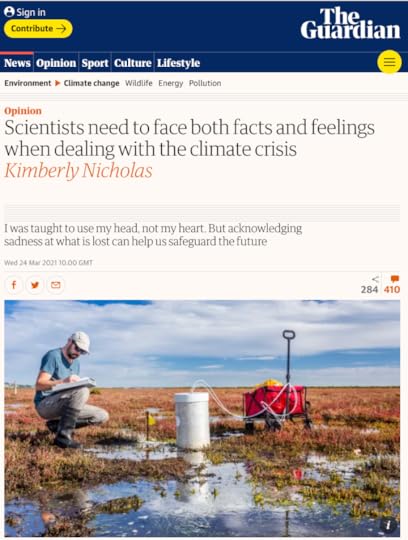 a.image2.image-link.image2-675-510 { padding-bottom: 132.22222222222223%; padding-bottom: min(132.22222222222223%, 674.3333333333334px); width: 100%; height: 0; } a.image2.image-link.image2-675-510 img { max-width: 510px; max-height: 674.3333333333334px; }
a.image2.image-link.image2-675-510 { padding-bottom: 132.22222222222223%; padding-bottom: min(132.22222222222223%, 674.3333333333334px); width: 100%; height: 0; } a.image2.image-link.image2-675-510 img { max-width: 510px; max-height: 674.3333333333334px; } Action: Actually call your rep. Complain about cars.“Over the course of my career, the climate crisis has changed from something only experts could see – reading clues trapped in frozen air bubbles or statistical patterns in long-term data sets – to something that everyone on Earth is living through. For me, it has gone from being something I study to a way that I see the world and experience my life. It’s one thing to publish a study on the hypothetical impact of increasing temperature on California’s people and ecosystems; it’s another to feel my stomach gripped by fear as my parents flee a catastrophic California wildfire cranked up by longer, hotter, drier summers.
Bearing witness to the demise or death of what we love has started to look an awful lot like the job description for an environmental scientist these days. Over dinner, my colleague Ola Olsson matter‑of‑factly summed up his career: “Half the wildlife in Africa has died on my watch.” He studied biodiversity because he loved animals and wanted to understand and protect them. Instead his career has turned into a decades-long funeral…
My dispassionate training has not prepared me for the increasingly frequent emotional crises of climate change. What do I tell the student who chokes up in my office when she reads that 90% of the seagrasses she’s trying to design policies to protect are slated to be killed by warming before she retires? In such cases, facts are cold comfort. The skill I’ve had to cultivate on my own is to find the appropriate bedside manner as a doctor to a feverish planet; to try to go beyond probabilities and scenarios, to acknowledge what is important and grieve for what is being lost…
It has taken me a long time to come to terms with my climate and ecological grief, but swimming through it is the only way forward. One role environmental scientists can play is to be “stewards of grief, to hold the hand of society as we enter the unknown space of the climate crisis,” as my friend Leehi Yona so beautifully wrote when the IPCC’s 1.5C report launched. As scientists, we have had much more time observing the decline of what we love. We are further down the line of where we all must get to as a society, facing hard truths and still finding ways to be kind and resilient, to do better going forward, to get through this together. We still have so much we love at stake that is worth fighting for.”
In the January edition, we saw that we need to both make cars fossil free, and reduce driving, to meet climate goals. In last month’s edition of We Can Fix It, we learned that personally talking to your elected representative is a very effective, but under-used, climate strategy. We also learned the climate delay tactic of focusing only on “carrots,” expanding good things, without acknowledging that “sticks” to restrict and reduce unsustainable systems are needed too. This month, we saw an experiment showing that supportive, voluntary “carrots” to reduce driving didn’t work.
So let’s put this knowledge together into action, and call our elected rep to support some sticks! This is a way to tell politicians that there is support for bolder and more effective policies, that they fear are unpopular.
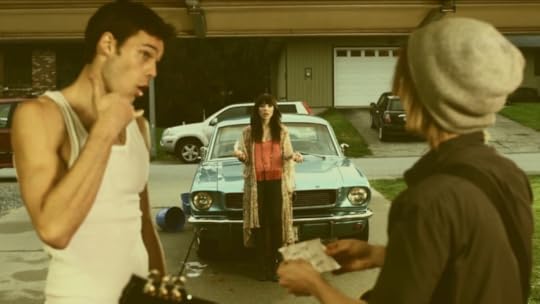 a.image2.image-link.image2-496-881 { padding-bottom: 56.29965947786606%; padding-bottom: min(56.29965947786606%, 496px); width: 100%; height: 0; } a.image2.image-link.image2-496-881 img { max-width: 881px; max-height: 496px; } Call your rep!
a.image2.image-link.image2-496-881 { padding-bottom: 56.29965947786606%; padding-bottom: min(56.29965947786606%, 496px); width: 100%; height: 0; } a.image2.image-link.image2-496-881 img { max-width: 881px; max-height: 496px; } Call your rep!Eeeek, calling a politician sounds scary, right?!? I’ll be honest: I have never in my life called my elected official. Despite knowing how effective it is. Because… it sounds hard?
Well, now I’m going to have to do it by next month, because I’m writing it here! And I bet it won’t actually take me more than 15 minutes, start to finish. Let’s try it out together.
So far in this newsletter, we keep running into the problem of the status quo, which is on a path to catastrophic climate change, and thus needs to be changed pronto. But the status quo has supporters, and they’re loud and well-organized. We need to get louder and better-organized. Let’s start local, at the city level.
Google who represents you in your city, and their phone number.
Give them a call. Say you’re a constituent (that means your vote determines whether they stay in office, and it is their job to care what you think). Ask to speak to the staffer who works on transportation and planning. (Maybe it will be the same person who answers the phone, but this sounds fancy!)
Tell this person you’re concerned that cars are given priority over people where you live. Name one specific example that affects you personally, like a street that’s unsafe for your kid to bike to school. I’m thinking of trying something like this:
“Hi, my name is Kim Nicholas. I’m a constituent from Lund. I’m concerned that cars are given too much priority in Lund, and it reduces the quality of life in the city. For example, the square near my house, Mårtenstorget, alternates between a beautiful farmers’ market, and an ugly parking lot. It’s such a shame to have this prime location in the heart of the city be dedicated to cars instead of people. I would love to see it be used as a park, with green space and benches like the popular ones in Stortorget that are always full. A fountain like the new one in Bantorget would look beautiful. And a community garden would be such a great way to bring neighbors together; it would be a perfect project to depave. Would you please consider reducing the city space devoted to cars? Thanks so much for your hard work.”
For bonus points, coordinate with friends to make their own calls to raise the issue higher.
Then give yourself a big high five. Yay democracy! Let us know how it goes in the comments below!
Now that you’ve had your stick, you can also have your carrot: support groups doing good things, like cycling and car-free cities. They would probably also love you to volunteer. Look for ones near you, or support two that I think are awesome:
The San Francisco Bicycle Coalition, who organized a wonderful bike tour of the city I joined a few years ago, and are doing great work for equity, and
Possible, which has a great car-free cities campaign, and also an upcoming online Climate Cabaret featuring a burlesque from a performer named Carmen Emissions, which is obviously the place to be on April 15.
Parting Thoughts & TidbitsRocking out on PRI’s The WorldI got to speak with the program The World on Public Radio International about low-carbon love, getting through doom to purpose by way of all the feels, and my “If my book were music” playlist. Listen to the interview here:
 a.image2.image-link.image2-240-529 { padding-bottom: 45.23470839260313%; padding-bottom: min(45.23470839260313%, 239.29160739687055px); width: 100%; height: 0; } a.image2.image-link.image2-240-529 img { max-width: 529px; max-height: 239.29160739687055px; } Recently Enjoyed:
a.image2.image-link.image2-240-529 { padding-bottom: 45.23470839260313%; padding-bottom: min(45.23470839260313%, 239.29160739687055px); width: 100%; height: 0; } a.image2.image-link.image2-240-529 img { max-width: 529px; max-height: 239.29160739687055px; } Recently Enjoyed: Read: The Loneliest Polar Bear, by Kale Williams. The story of Nora the polar bear and the people who love her is both heart-warming and -breaking. It’s a meditation on loss but also justice, colonialism, animal ethics, and how we could do better.
Eat: This was a busy month where I appreciated simple, quick dinners. This Baked Potato with Broccoli and Cheddar from Serious Eats did the trick!
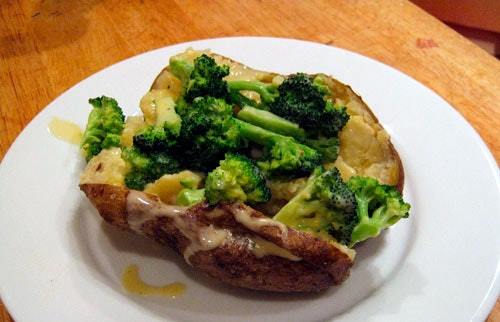 a.image2.image-link.image2-322-500 { padding-bottom: 64.4%; padding-bottom: min(64.4%, 322px); width: 100%; height: 0; } a.image2.image-link.image2-322-500 img { max-width: 500px; max-height: 322px; }
a.image2.image-link.image2-322-500 { padding-bottom: 64.4%; padding-bottom: min(64.4%, 322px); width: 100%; height: 0; } a.image2.image-link.image2-322-500 img { max-width: 500px; max-height: 322px; } P.S. You can still join the private book club for We Can Fix It subscribers on May 2 to discuss Under the Sky We Make with Kim and friends if you register by March 28th! See details here.



